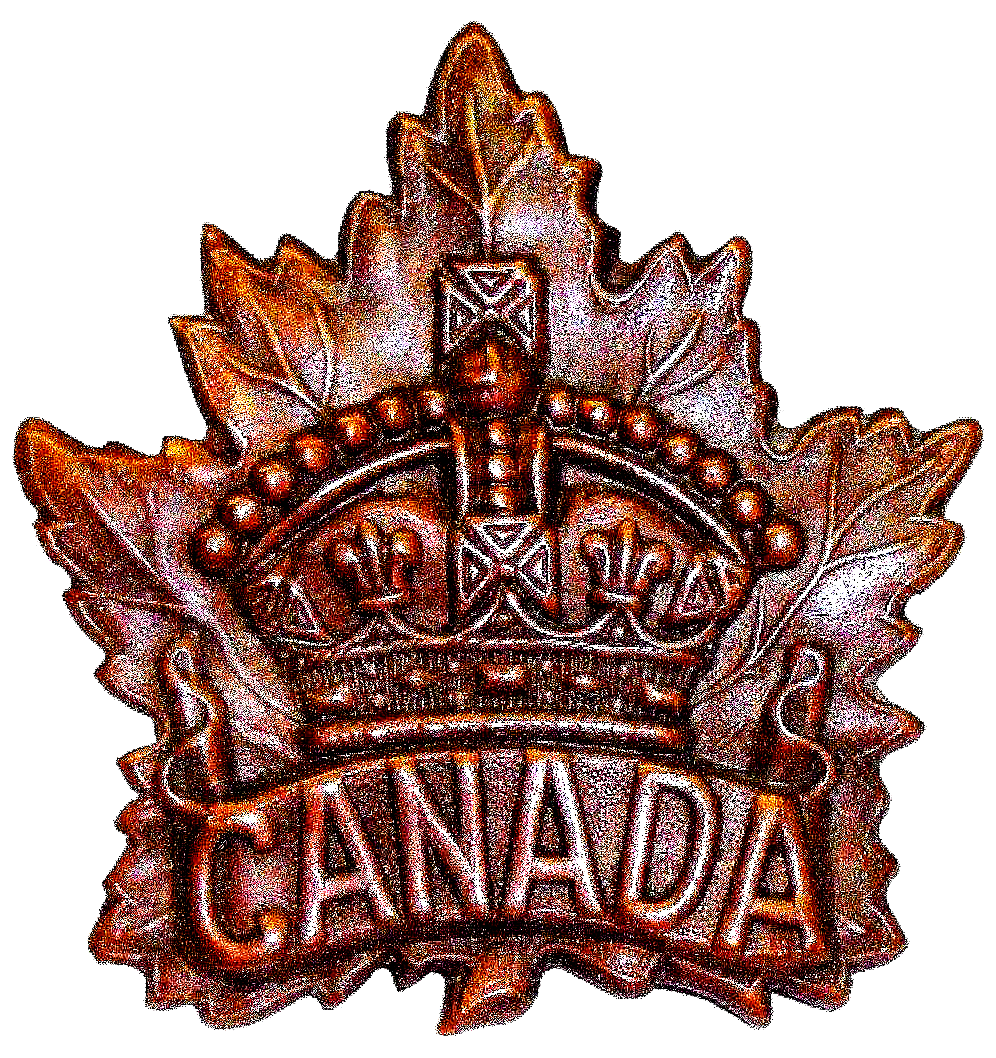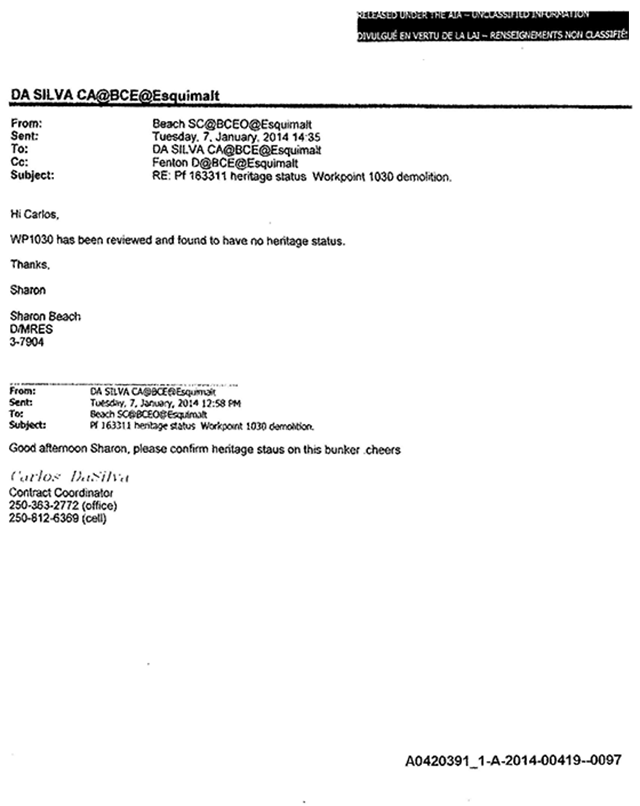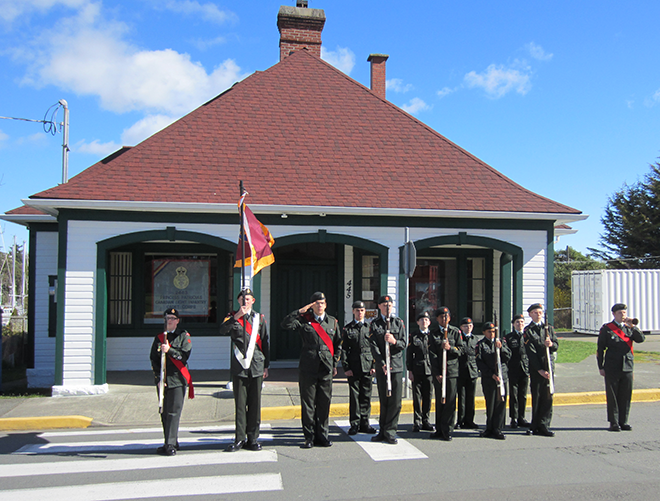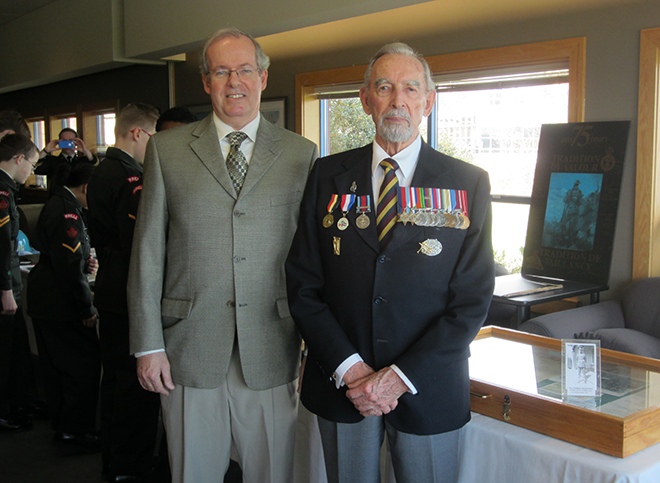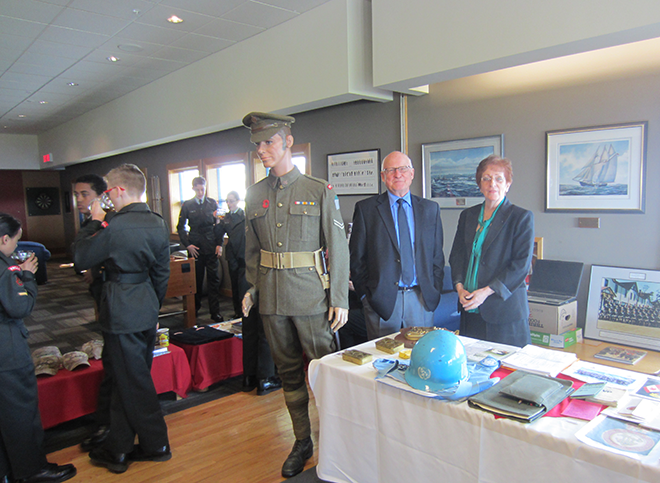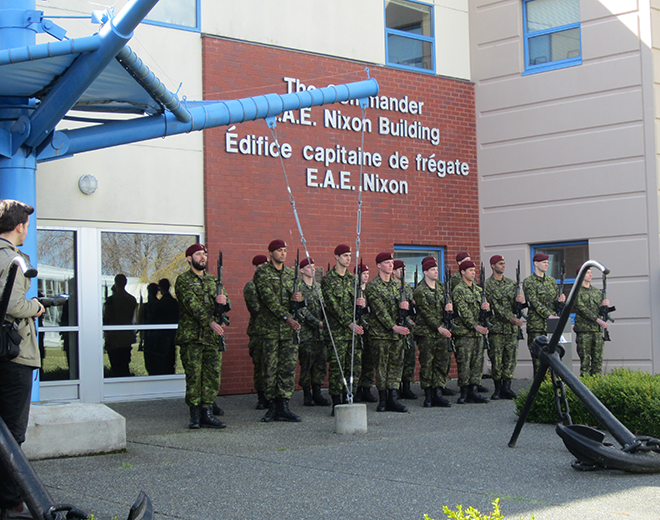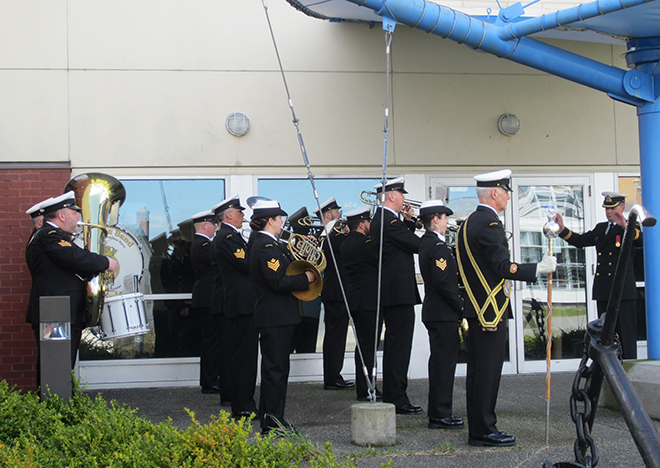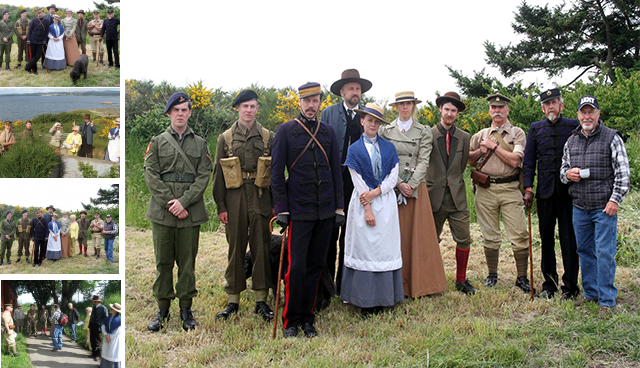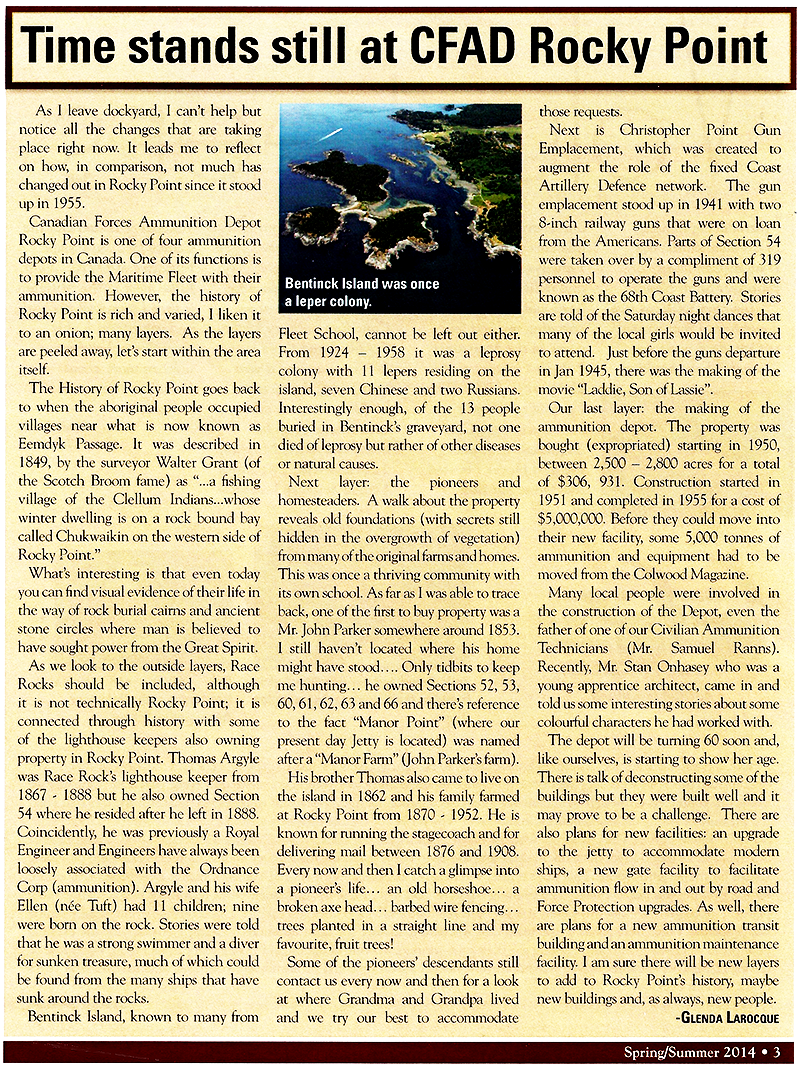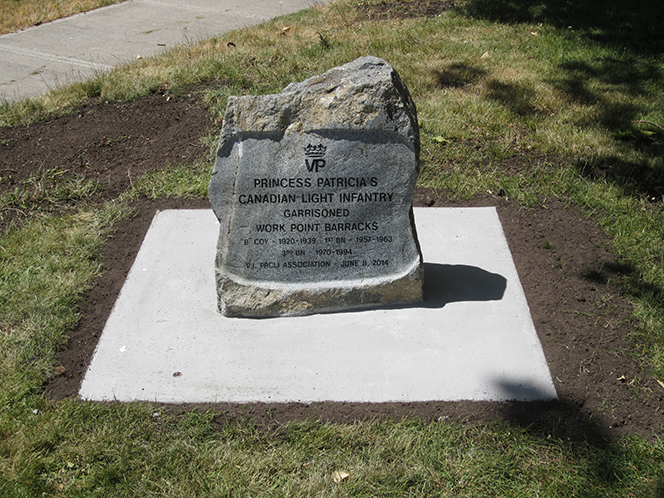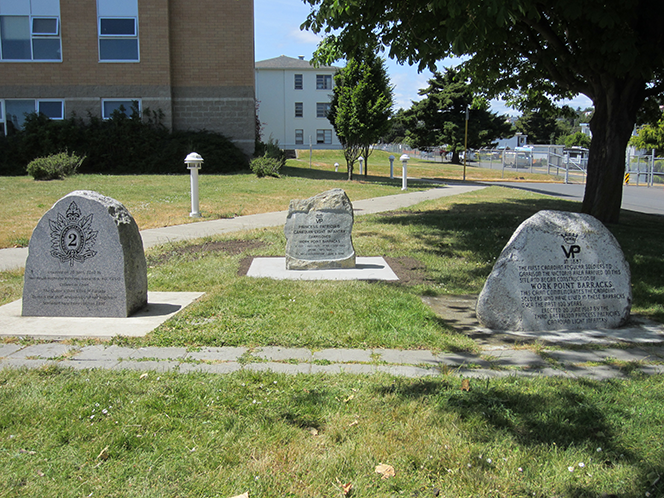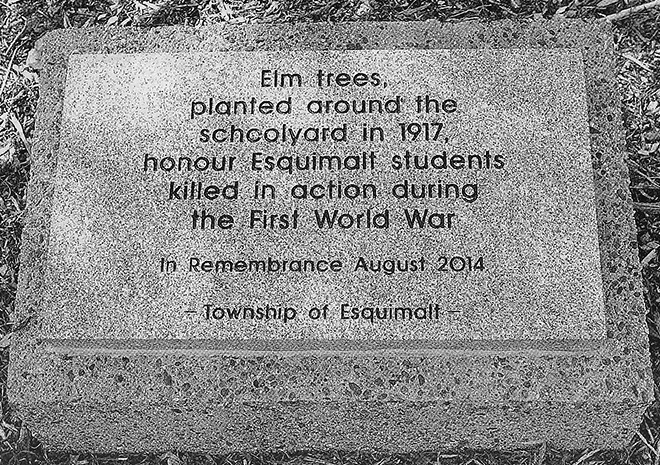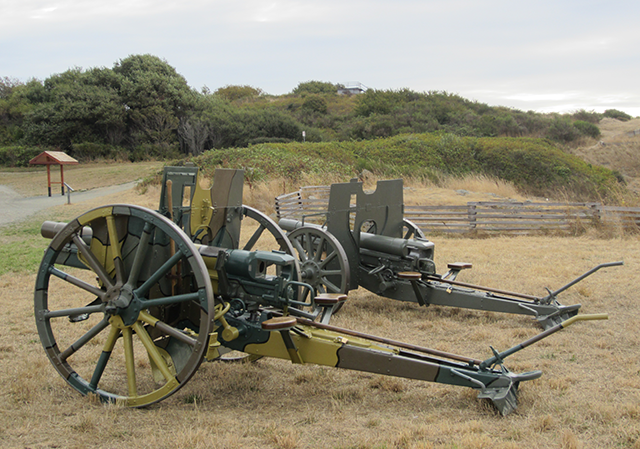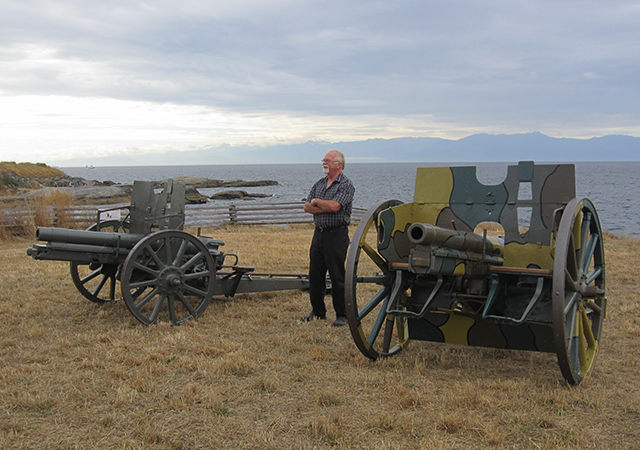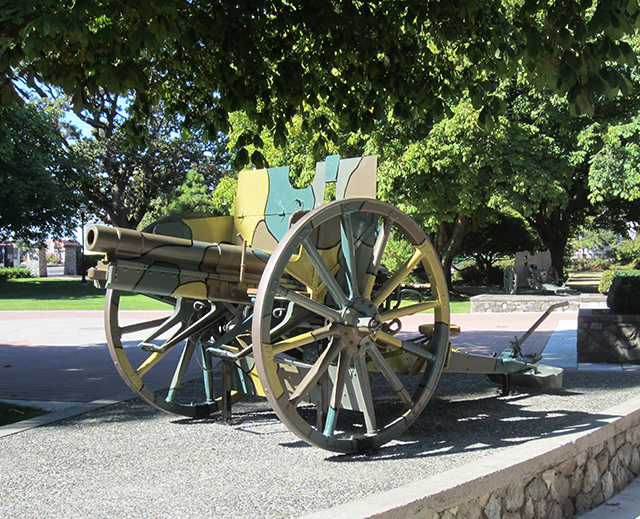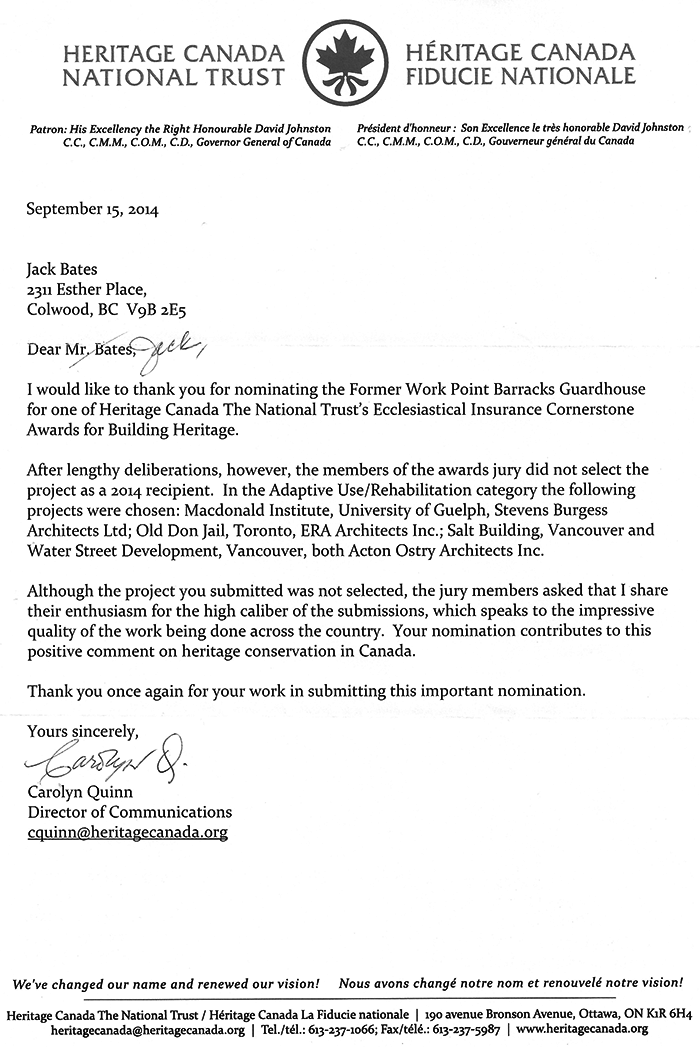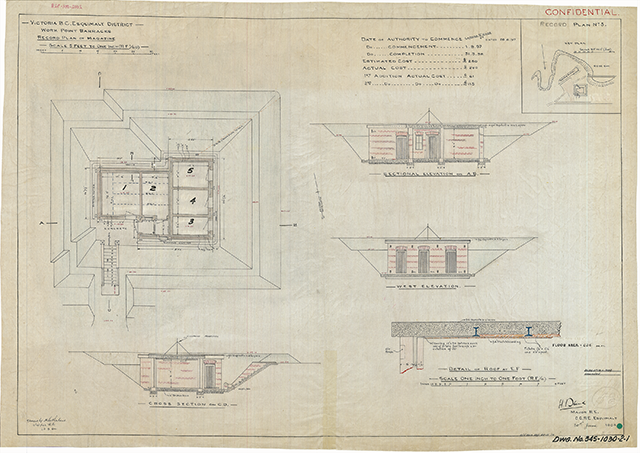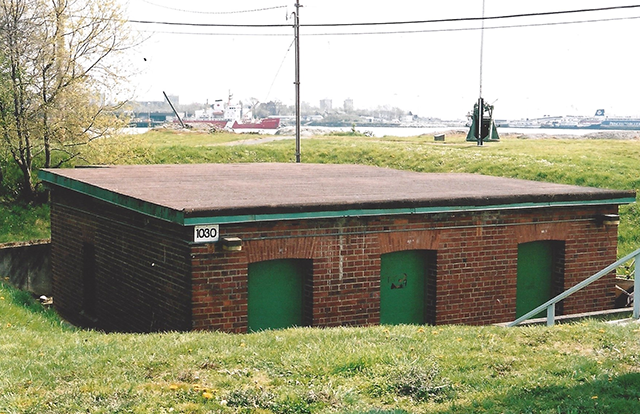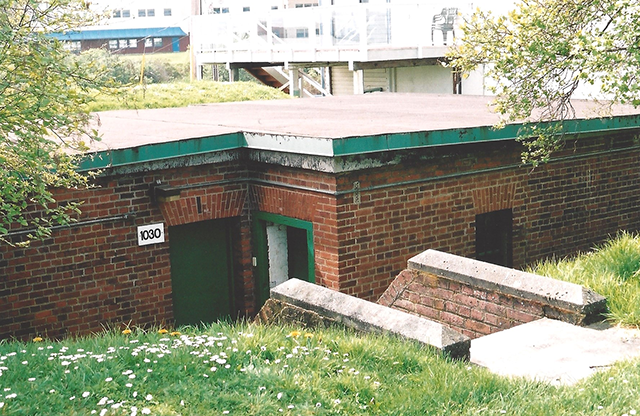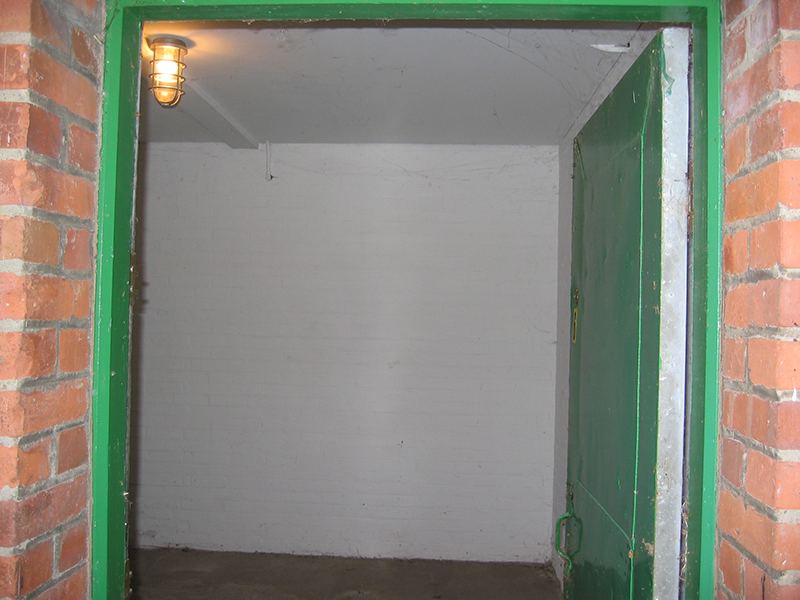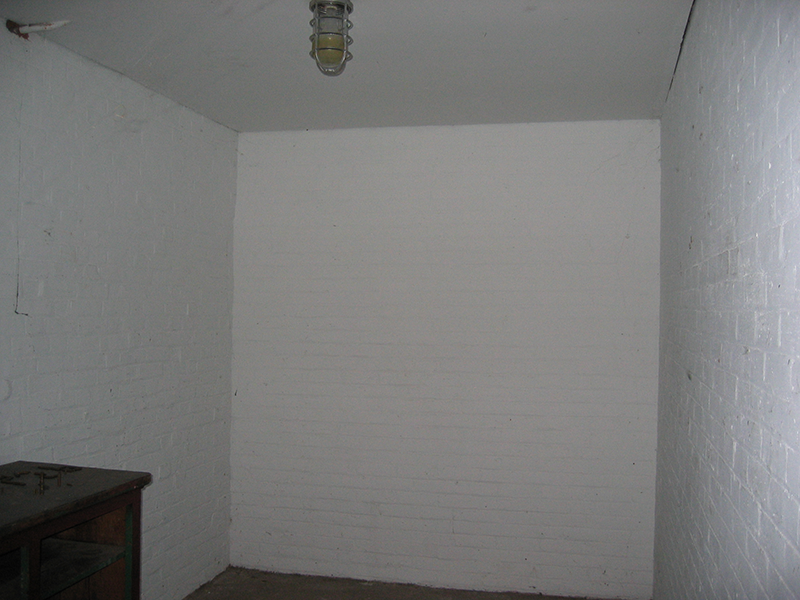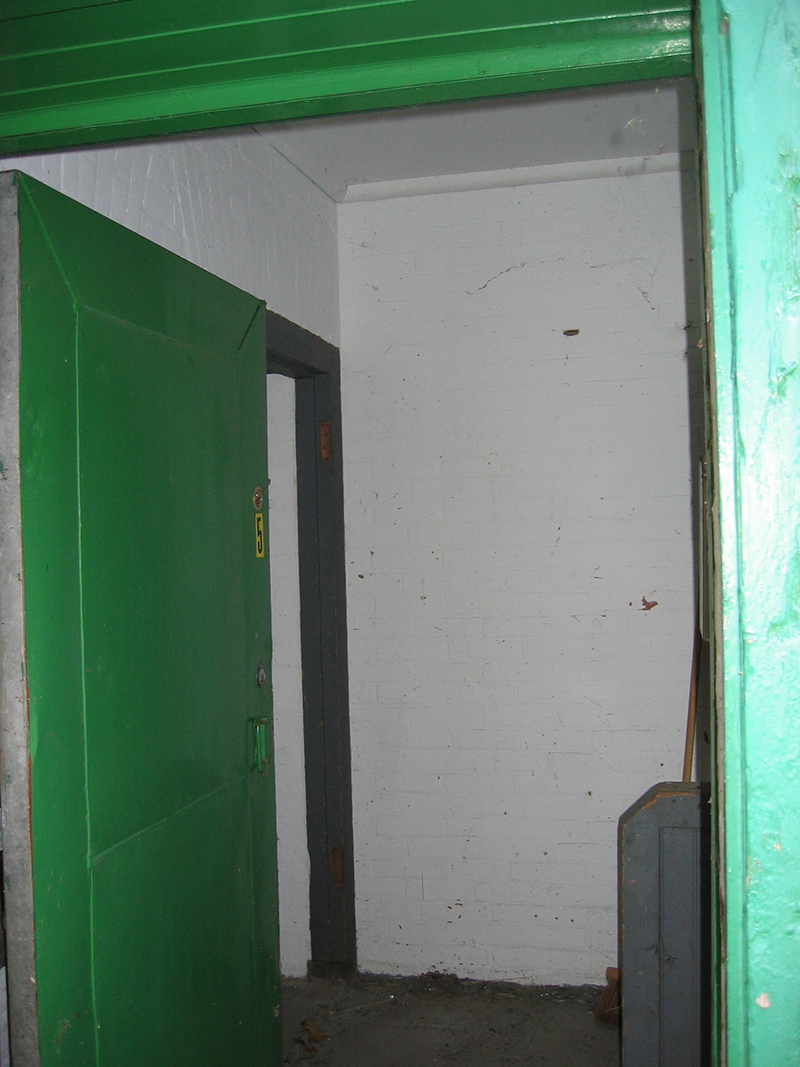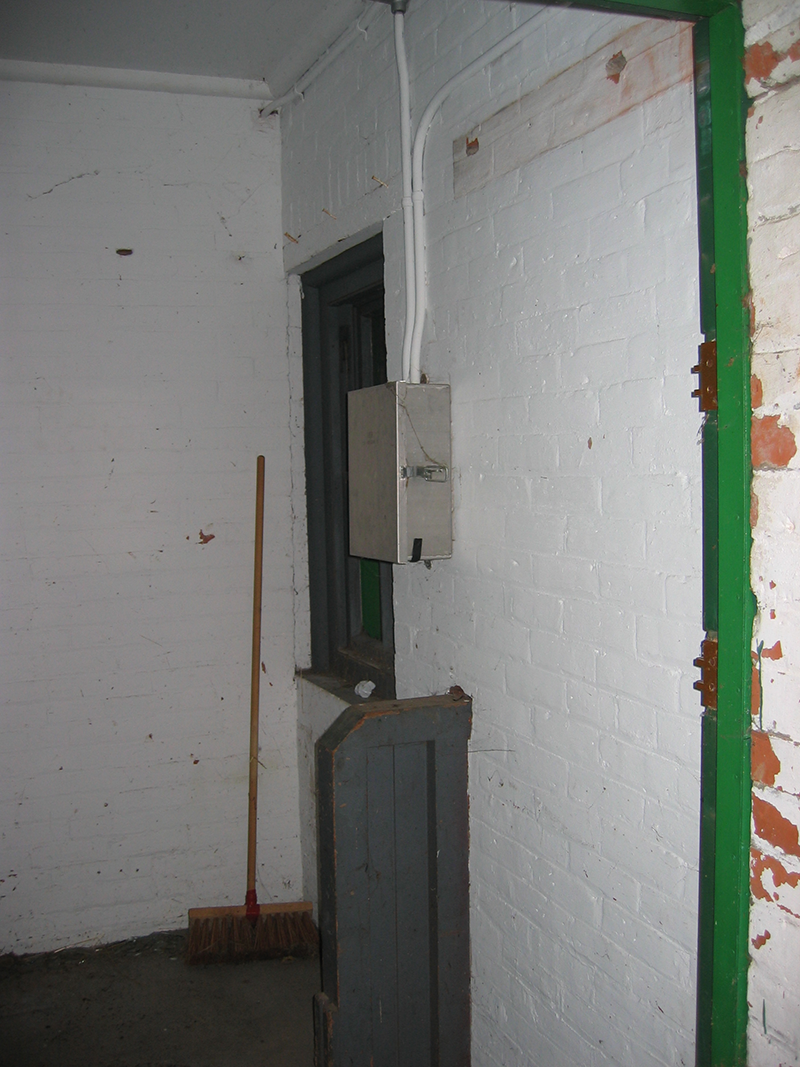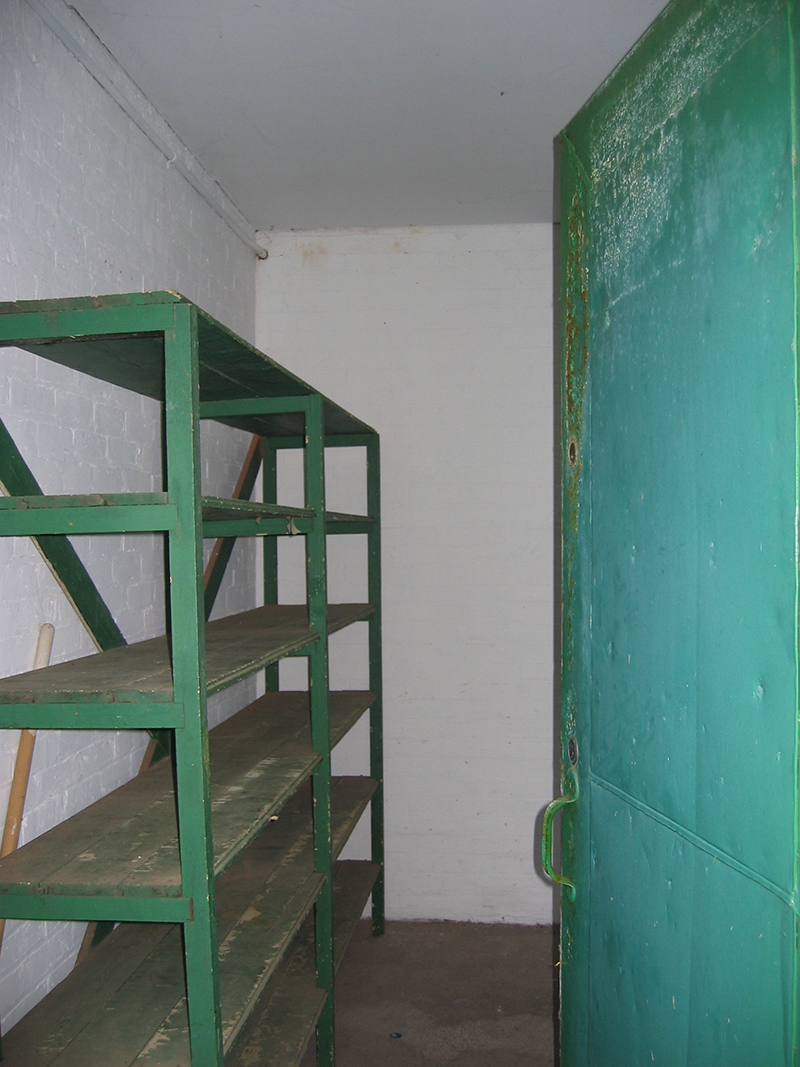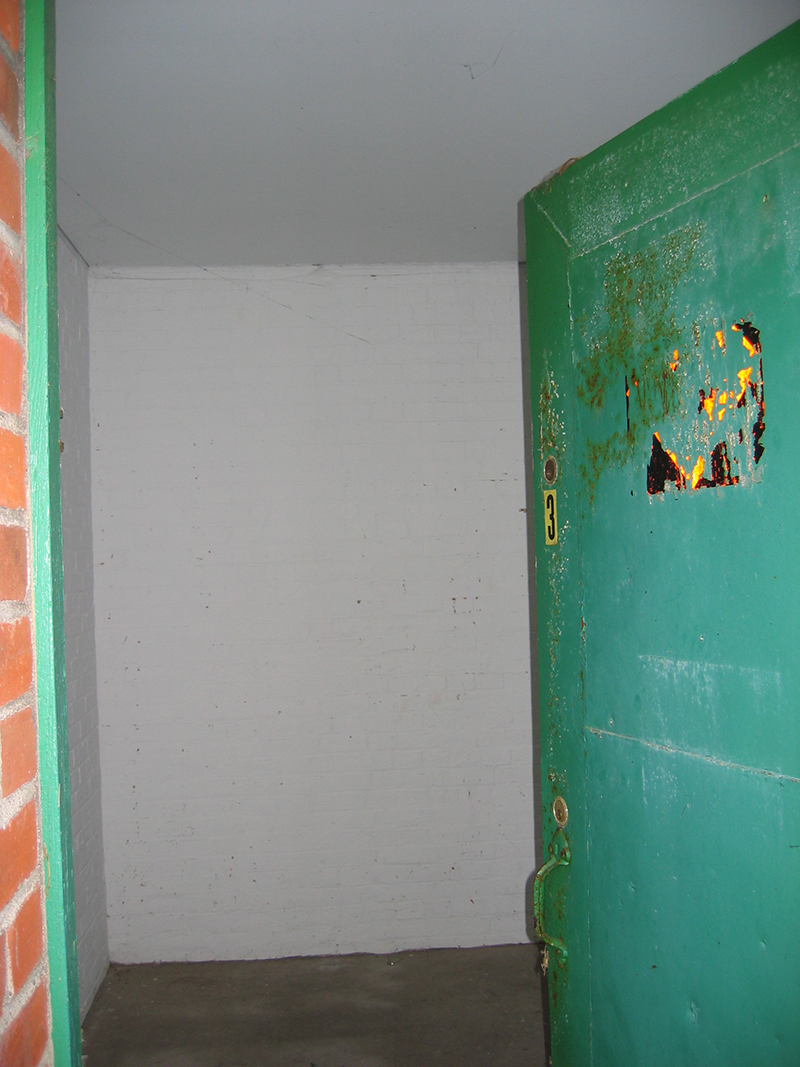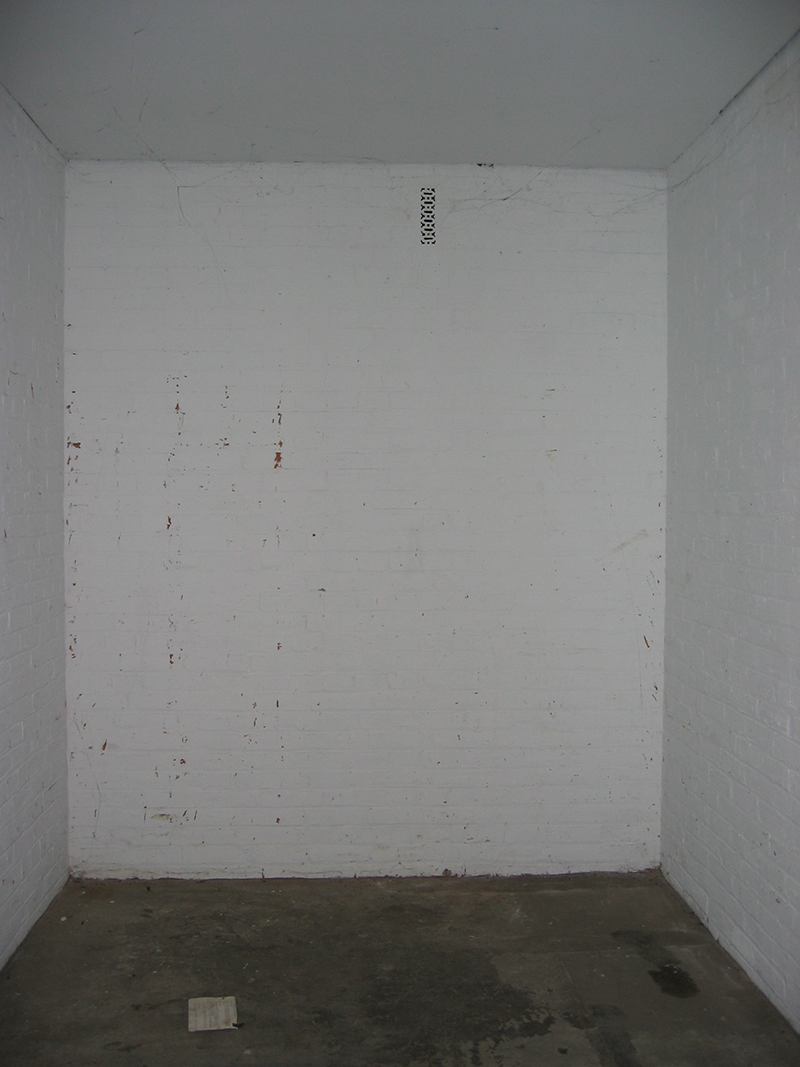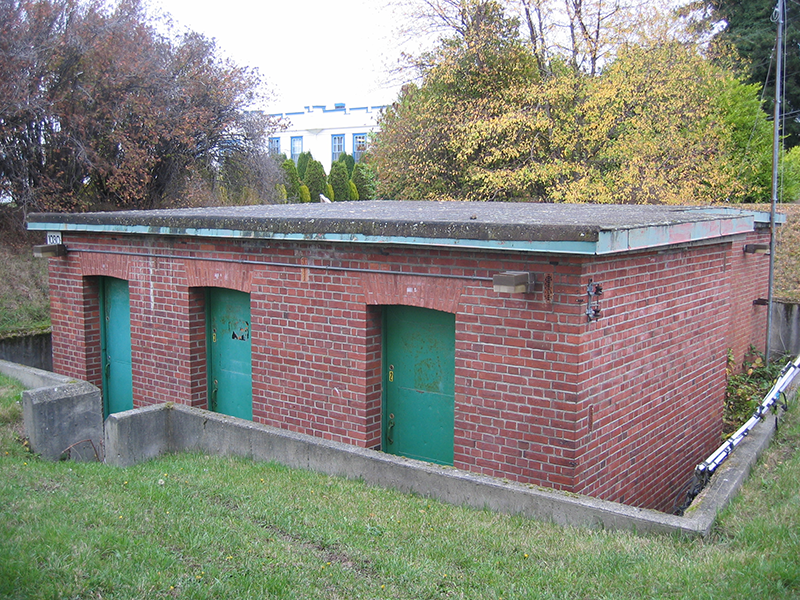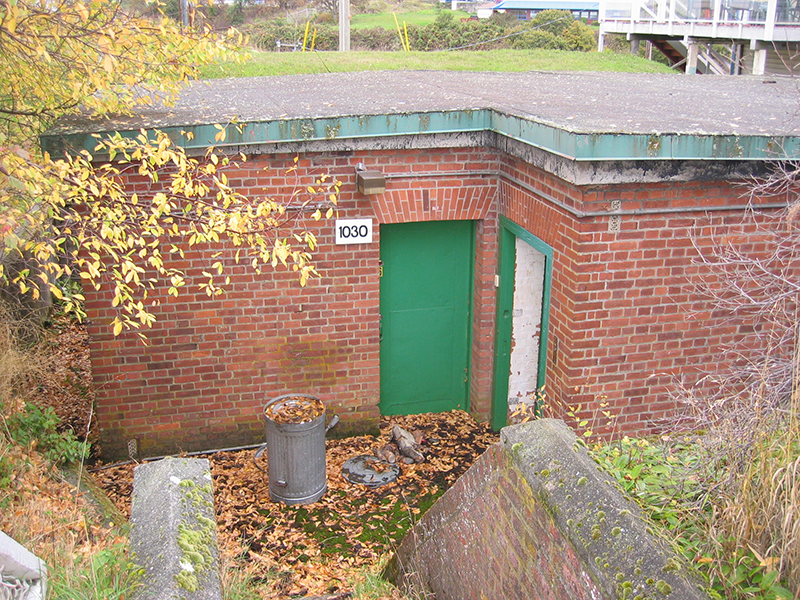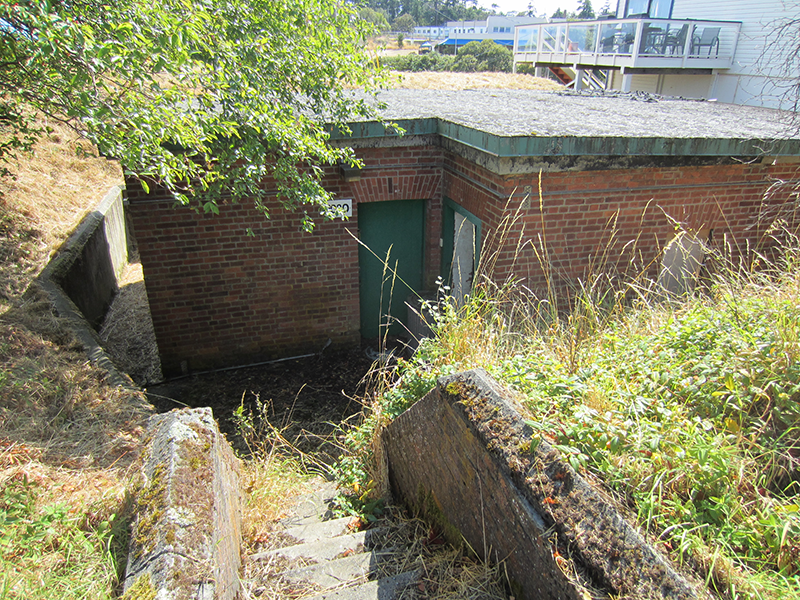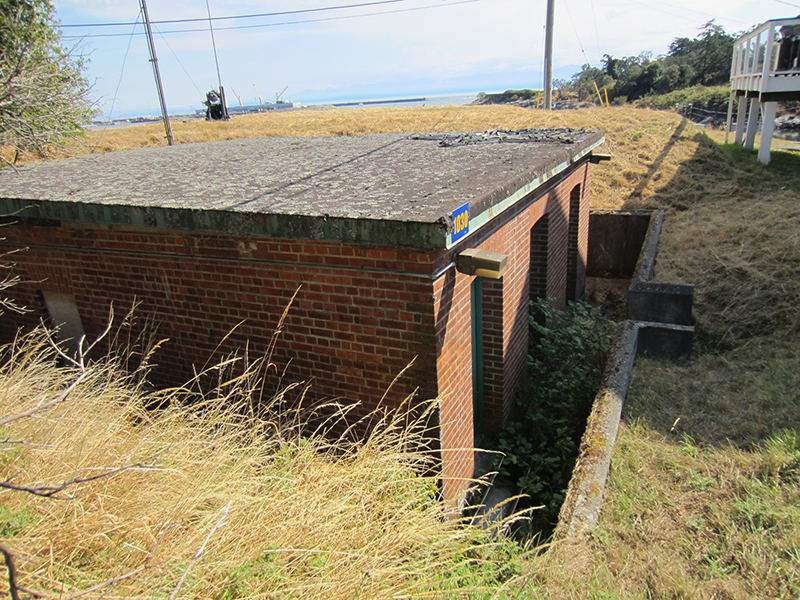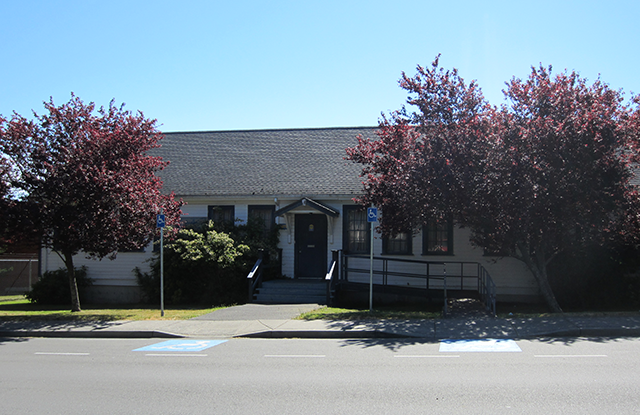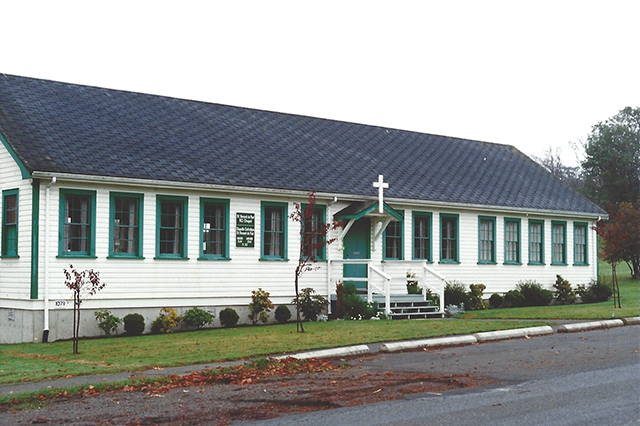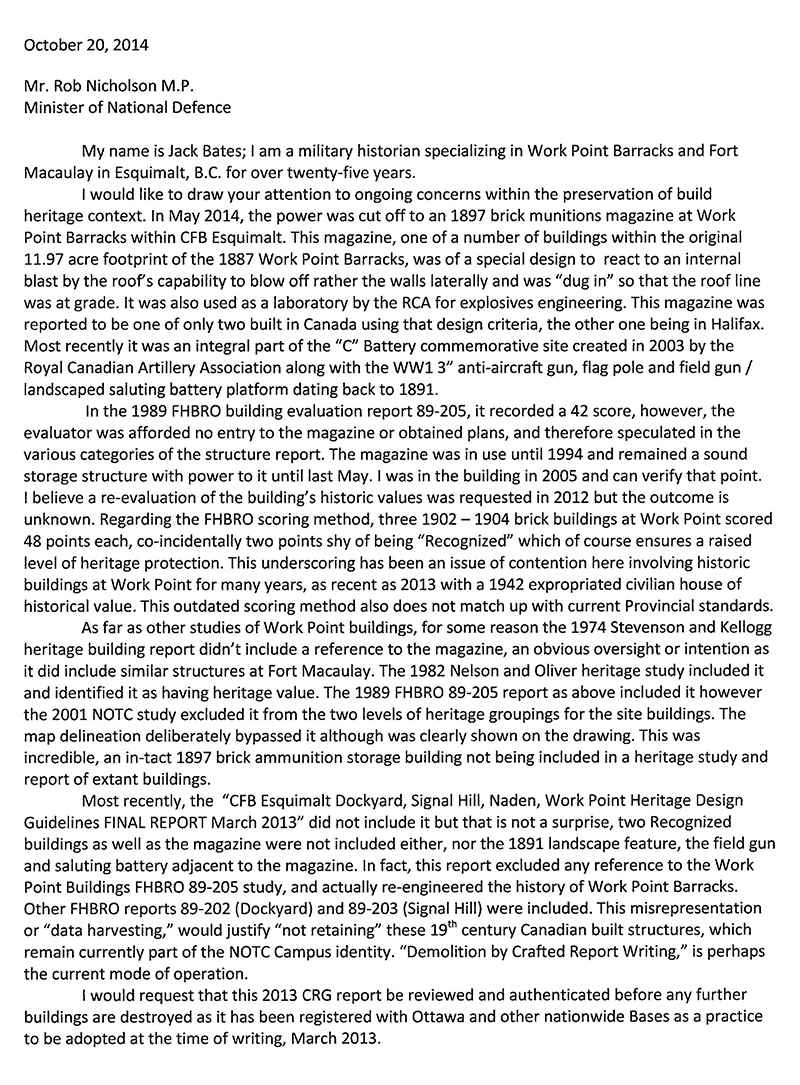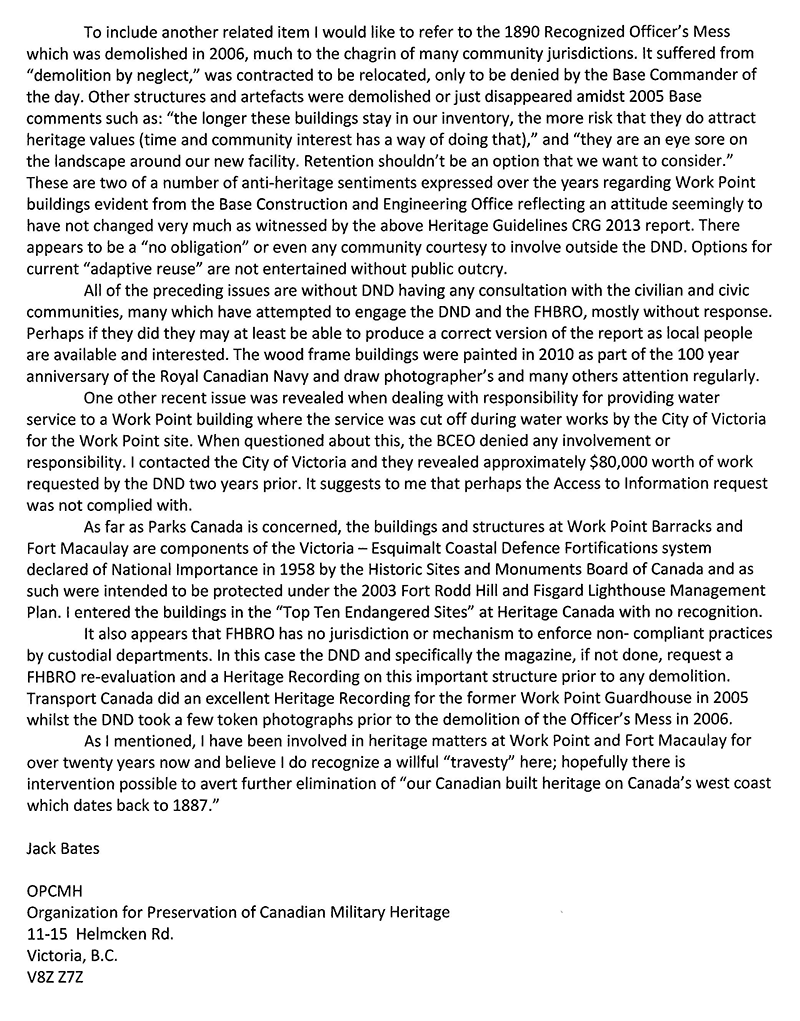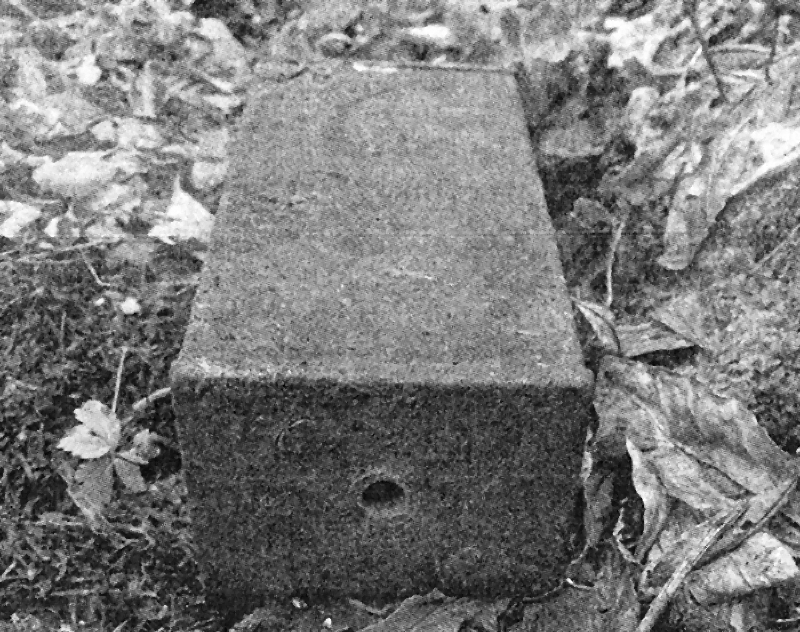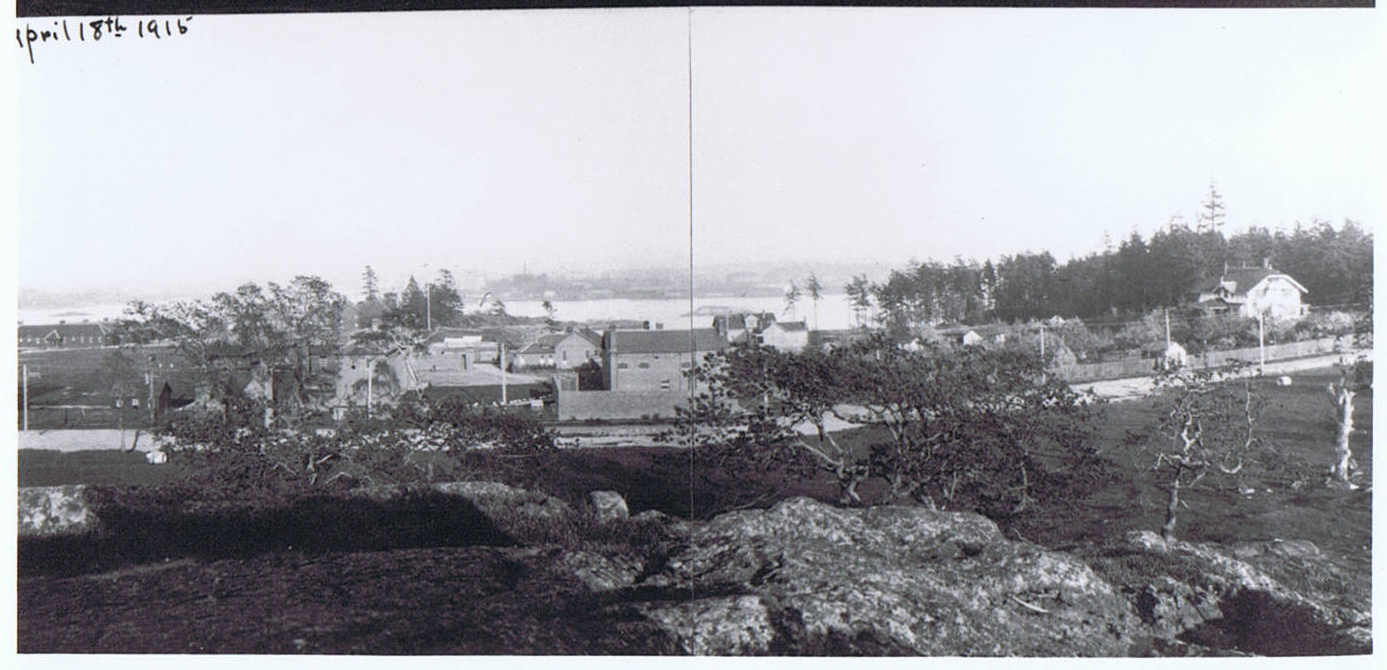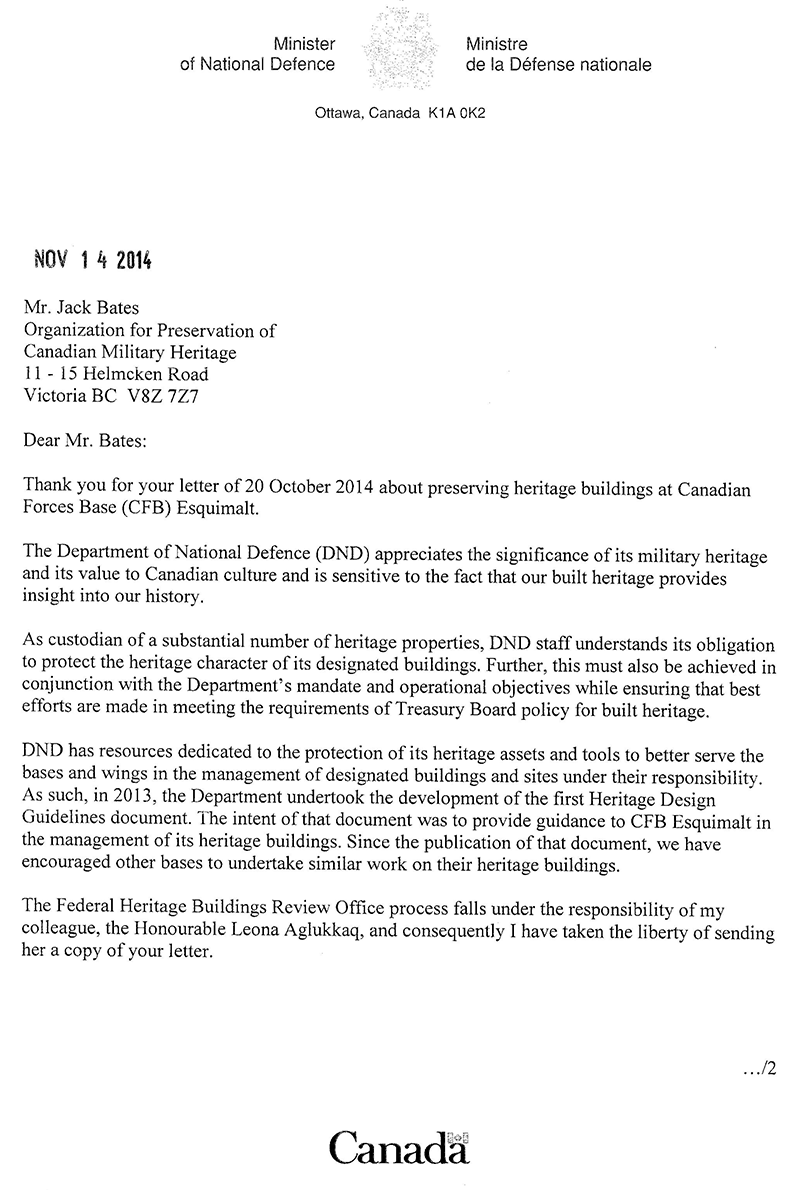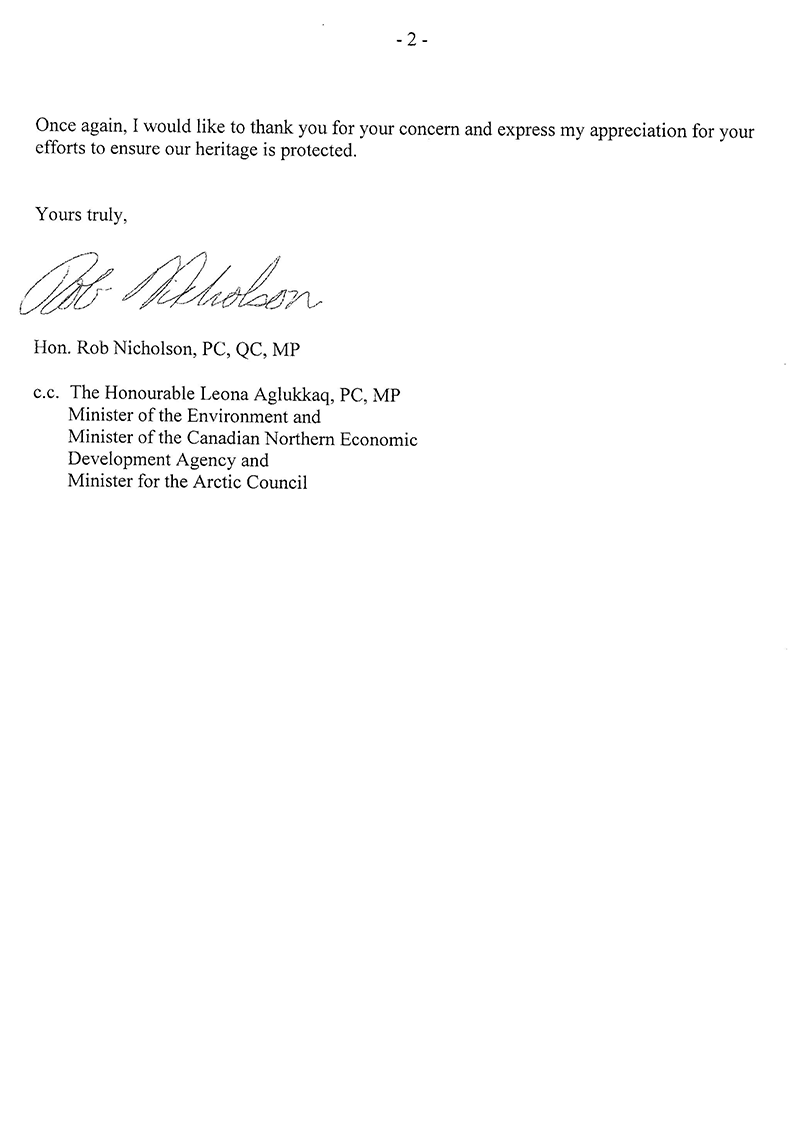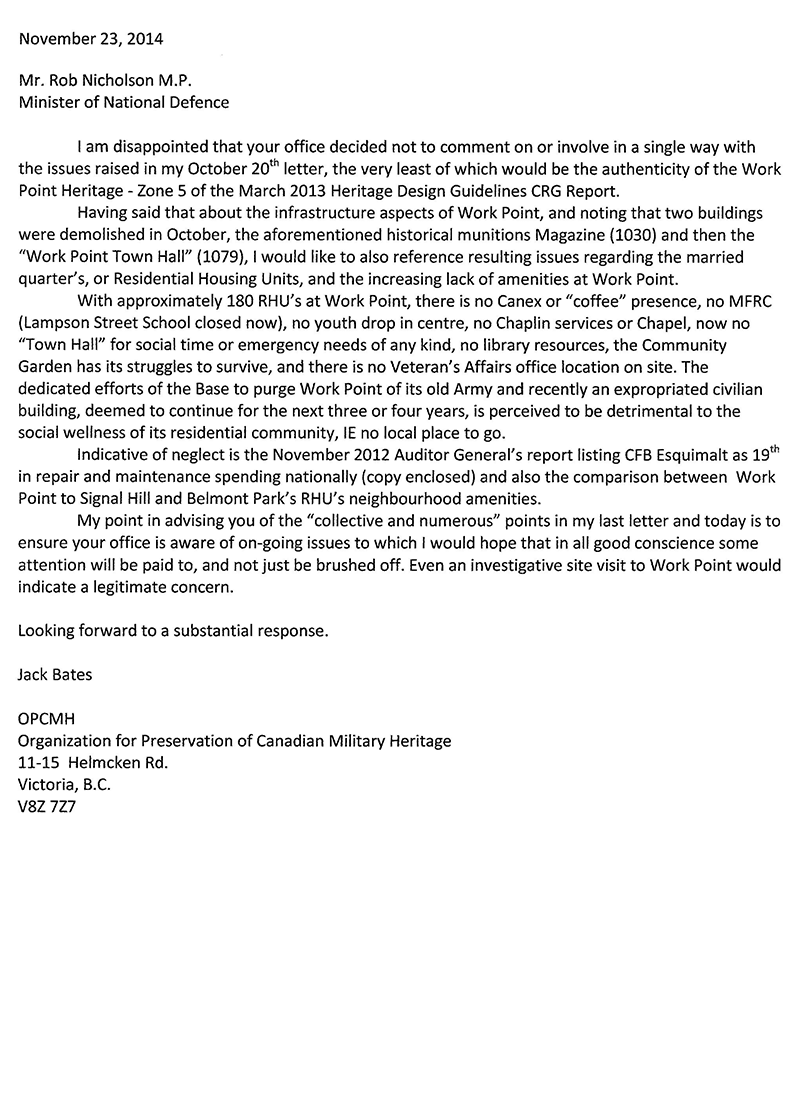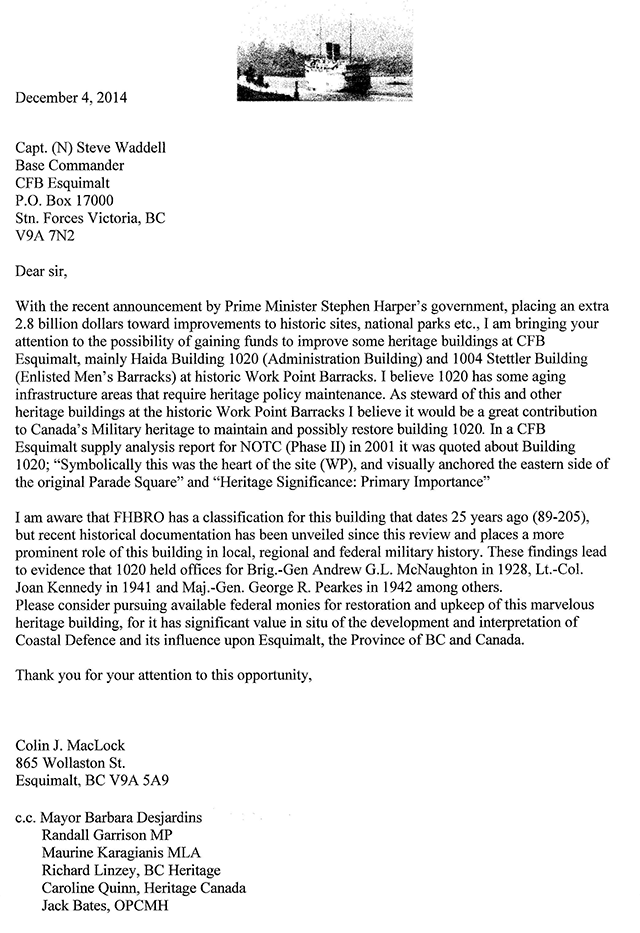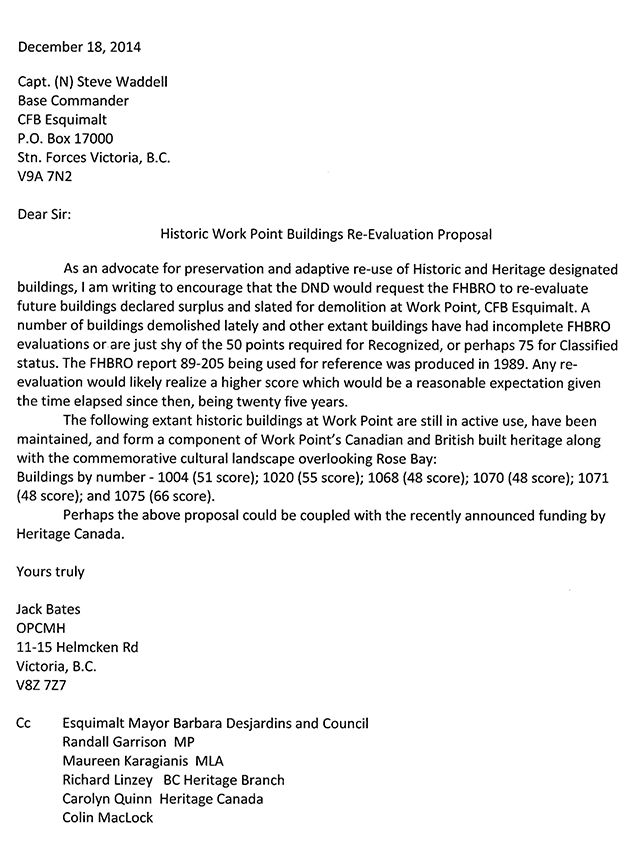 |
 OPCMHVisitor No.: |
HISTORY OF WORK POINT BARRACKSby Jack BatesPART 10 — 1995 to 20222014WP 1030 Confirmation of WP 1030 having no FHBRO RECOGNIZED heritage status. However, previous DND reports (1974 and 1982) indicated heritage value to be considered. The 2001 NOTC report excluded it from its Heritage Grouping Plan and a lack of inclusion in the 2013 CFB Esquimalt Heritage Report. This was a complete travesty, FHBRO report 89-205 scored it an inconclusive 42 points, due diligence was not performed here, and the PILT was $89 per year, strictly a matter of getting rid of it, regardless of its values. This was a final stroke of the pen that sealed the fate of the 1898 Work Point Barracks Magazine, WP 1030. A stretch by any means to conclude that it was found to have no heritage value. It was a travesty for sure, another case of “dozer bait,” to use the BCEO term of the day. This also confirms the lack of responsible concern in built heritage interests at Work Point contained in the CRG CFB Esquimalt Heritage Design Guidelines completed in 2013, and of course the old theme, “demolition by neglect.”
DEPARTMENT OF NATIONAL DEFENCE My request to the DND for records of the dealings with Nickel Bros. regarding the relocation or demolition options in a contract for 1027, the Officer’s Mess and Quarters building, revealed the series of events dating back to 2001. The building eventually just came down, which was the bottom line for the DND, much to the chagrin of the community. COLONIST ESQUIMALT’S FLAG DESERVES RESPECT Re: “Esquimalt rallies around its flag,” Jan. 8. The article and a subsequent letter to the editor seem to imply that the Township of Esquimalt does not have its own flag. We have had our own flag since the late 1950’s, and at one time, it flew proudly on some of our municipal buildings. For far too many years, we have only seen it in our council chamber along-side the Canadian flag and the B.C. flag. Our flag supports our coat of arms emblazoned on a white background, flanked on either side with royal blue panels. Our motto, “Es Whoy Malth,” is featured beneath the coat of arms. The coat of arms, presented to Esquimalt by the Lieutenant-Governor of British Columbia in 1957, speaks to who we are as a Township. The coat of arms is registered with the College of Heralds in England and also in Canada. The copyright was registered in British Columbia in 1958. It should be hung outside our municipal hall for all to see and not only on special occasions. It should not be mass-produced for all to use. It is our corporate flag and it deserves our respect. Sherri Robinson Victoria News WAR TROPHIES RECALL ARMY PAST First World War Cannons in Esquimalt Tell a Colourful Story Look closely at the smaller of the two 77 mm field guns in Esquimalt’s Memorial park and its battle-weary wounds begin to show. The punctured metal hints at shots fired by the 2nd Canadian Mounted Rifles before they overwhelmed the Germans at Vimy Ridge on April 9, 1917. The Regiment, made up of mostly Victoria based soldiers, seized the anti-tank gun as one of nearly 400 war trophies that would eventually make their way into the hands of Canadian municipalities following the First World War. “This is a storm trooper gun.” says Mike Reed with Esquimalt’s public works department. “The Germans put smaller wheels on it and stripped the unnecessary pieces so troops could pull it to the front line and embed it tighter to the ground.” Across the park sits a similar weapon, one equipped with larger wheels and shielding. The German 77 mm Feldkanone 96 neuer Art field gun was taken at the second battle of Cambrai on Sept. 29, 1918. The cannons comprise two of only three known First World War German field guns in the province, says Colin Wyatt with the Ashton Armoury and Museum in Saanich. “Most of these guns went back into scrap at the beginning of the Second World War,” Wyatt says. Three quarters of Canada’s war trophy guns were melted down for scrap metal as the war machine ramped up once again, including two similar weapons on the grounds of the B.C. Legislature in 1941 (See photo) “Apparently, there was another gun at Beacon Hill Park, and one in Oak Bay, but Esquimalt’s are the only two that were saved when we incorporated them as part of our war memorial,” Reed says. On February 11, public works staff removed the guns to begin glass beaded blasting and refurbishment of corroded metal parts in the run up to the 100th anniversary of the start of the First World War in August. “In the last number of years, we’ve seen the Naval Centennial and now we’re looking at the First World War centennial leading up to the 150th anniversary of Canada,” says Mayor Barb Desjardins. Great War Plaque Destined For Lampson “The connection for our community with the military is huge, and there’s a lot of people who still miss that connection to the army. I had a grandfather at Vimy Ridge.” When the Canadian government gifted Esquimalt the guns in 1920, they were sited at Lampson elementary for five years to commemorate students who had lost their lives in the Great War. Desjardines said the Township will put a memorial plaque at Lampson to recognize that history as well. In the meantime, Reed and Wyatt continue their feverish research to restore the guns as accurately as possible to their original colour and style. “Nobody seems to know what the true colour was,” Wyatt says. “I think they must have ha these guns in different colours – not intentionally, they were all meant to be field green – but they varied from match to match. “People may have relatives who were involved in the fighting of these battles. We’d love to find out more about the history of those guns. We also don’t have any photographs of when they were first brought to Esquimalt, so we’d like to see those if they are around.” Reed hopes to return the field guns to Memorial Park in July, as well install accent lighting on the platforms surrounding the war memorial. “I’m dealing with some Pennsylvania guys who restored a piece like this 20 years ago,” he says. “They’re sending me colour samples on little sticks. So we’re really trying to get this right.” Mounted History Library and Archives Canada records show the 2nd Canadian Mounted Rifles )CMR) was organized in Dec. 1914 under the command of Lt. Col. C.L. Bott. The regiment was mobilized at Willows Camp in Oak Bay and recruited form the 30th B.C. Horse (Vernon) and the Victoria Independent Squadron of Horse. The regiment left Montreal in June 1915 bound for England. Photo Times Colonist IN ESQUIMALT, GERMAN FIELD GUNS FOUND AN ESCAPE FROM BATTLEFIELD In a cavernous storage unit on Viewfield Road, municipal worker Mike Reed is working on a project unlike any other in his career. The facilities operations supervisor for the Township of Esquimalt cracks a smile as he leans over the smaller of the two german field guns. “This is really the holy grail of artillery pieces,” Reed said of the gun, captured in 1917 by the Victoria area soldiers of the 2nd Canadian Mounted Rifles. “It was captured at Vimy Ridge, (where) Canada really came into its own as a nation.” Reed is restoring the historic guns, which have spent most of their lives in Esquimalt’s Memorial park, as part of the township’s commemoration of the First World War. The guns arrived in Esquimalt as two of 516 guns that Canada collected as “war trophies.” The capital region alone received six, one was stationed at Beacon Hill Park, another in Oak Bay and two more outside the legislature, according to Reed. As the Second World War escalated in 1941, about 75 percent of the country’s war trophies were turned into scrap metal, melted down and reincarnated as new military material. The pair in Esquimalt may be the only remaining German field rifles in the province, Reed said. “These were declared part of the war memorial by the council of the day and were saved from that fate,” he said. Serial numbers identify the larger gun as a 7.7 cm Feldkanone, model 1896 neuer Art, which the same Victoria battalion captured September 29, 1918, at Cambrai. The smaller one is a short range combat weapon designed for anti-tank use, captured April 9, 1917, at La Foli farm. It has smaller wheels and extra weight such as foot stools removed, enabling it to fit in smaller places, dips in landscapes and shell holes. Reed points to multiple piercings in its armour, as well as the way it is stuck in partial recoil, as evidence that it was abandoned during the battle. Both guns were placed at Lampson Street school in 1919 and moved to Esquimalt’s memorial park in the mid 1920’s, where they’ve slowly discoloured, rusted and rotted in the elements. Reed is committed to extending their lives. And he’s aware of the scrutiny his work will receive from a township with a rich history in combat. “Esquimalt is a military community,” he said. “I’ve got to cover all the bases.” Getting it right has turned into an international project. Reed has compared notes with an Ontario group restoring a similar German field gun and purchased a rare First World War era shovel that would have been strapped to the gun, from a seller in the U.S. Paint colour has become a particular obsession. Without colour photos to depend on, Reed was thrilled to find a military paraphernalia store about 30 kilometes outside of Gettysburg, Penn., that has the same 7.7 cm Feldkanone as Esquimalt. The owner had discovered original paint in the creases of another weapon, and Reed is trying to match it. He also asked a Hamburg based military outfitter to mail a dog tag painted with “German field grey” when he learned a pressurized can of the paint wasn’t allowed on planes. Reed expects to finish by early July and said he hopes his work extends the gun's lives. "It's not about preserving the memory of war, it's about preserving these so people will remember the kinds of sacrifices that were made." Lookout Canada Post Recognizes PPCLI With Centennial Envelope In a well attended gathering in the Naval Officer’s Training Centre (NOTC) Venture gunroom, Canada Post honoured the history of Princess Patricia’s Canadian Light Infantry (PPCLI). To celebrate the regiment’s 100th anniversary, a special edition envelope was launched. It commemorates the contributions and sacrifices made by members of the PPCLI. The unveil date was chosen because March 17 is the birthday of Princess Patricia, after whom the infantry was named. She was Queen Victoria’s granddaughter and the youngest daughter of Prince Arthur, who was Governor General of Canada. “Canada Post is honoured to pay homage to PPCLI with this commemorative envelope on a day as significant as today,” said Kevin Pearson of Canada Post, who was on hand to make the presentation. “We believe it is a fitting way to honour the regiment, marking its 100 years of service, and believe it will bring the regiment’s proud and illustrious history to home across the country.” A historic photo spans the length of the envelope, recalling the “Pat’s” early days with a placing of a wreath on the Regimental colour in February 1919. A row of images along the bottom capture the Regiment’s participation in the First and Second World Wars, the Korean and Afghanistan conflict, and a peacekeeping mission in Cyprus. The cancel mark features the letters and coronet from Princess Patricia’s royal cypher. The Princess’s two first names, Victoria Patricia are visible on both the stamp and the cancel shown as “VP.” On the backside is a synopsis of the regiment’s history. “This small gesture is part of the larger gratitude felt by Canadians everywhere,” said Pearson. “Anything we can do to recognize the service provided by regiments like the PPCLI, especially after a century of service, is a definite priority.” Judith Guichon, Lieutennt Governor of British Columbia, helped unveil the the envelope. She spoke to the assembled on the pride Canadians feel for the regiment, and the contributions they made and continue to make today. “For the last 100 years, the Patricia’s have been present across Canada, and the world contributing to making the planet a better place,” she said. “From the Second World War to conflicts in modern theatres across the globe, the Patricia’s are there, working, helping, and even giving their lives in service to Canada, and the principles for which it stands. It isn’t something we forget, and hopefully we are able to show you, even in some small way.” Lt. Gen. Ken Foster of the PPCLI took the podium to than Canada Post for its contribution, and the respect shown in the gesture. “What we do, and have done for the past 100 years, has been for Canadians,” he said. “To know we have the respective and gratitude of those we have spent sp long seeking to serve and protect is a great honour. As times goes on we will continue to give our all protecting the country and people we love so much.” Eight thousand commemorative envelopes have been printed, and can be purchased at Canada Post locations across Canada.
This event was well received by all those who attended, B Company, the Airborne Company of 3 PPCLI in Edmonton, attended and provided a Quarter Guard for the occasion. Pleasant to watch the expert drill perfomed, you don’t see that any more here in Victoria. I had the pleasure of organizing a display which all seemed to enjoy, with help from my sister Marilyn Day, friend Keith King (with WW1 Corporal King) and contributions from Bruce Dickey, Ed Widenmaier, Dougald Salmon and Nick Kerr. Bruce also provided a video of many PPCLI highlites which was played in the background during the day. It spanned the timeline of the PPCLI from WW1 to Afghanistan. One high ranking Canadian Naval officer in attendance remarked in conversation “Museums, museums, museums” in a negative fashion, I was not impressed or surprised. A “Centennial March” was played by the Naden Band, written by PO 2 Robyn Jutras for the PPCLI, a highlite of the day as well. The Canadian Stamp News, March 25-April 7, 2014, also published an article. On the same day, we took photographs of a ceremonial guard of the 2483 PPCLI cadets in front of the guardhouse, weather was perfect and a lot of pictures were taken. April 7, 2014 The two PMQ’s on Victoria View road, 300 and 338, have had their house #’s removed from their respective properties. This is to do with the proposed Waste Water Treatment plant at McLoughlin Point and DND relocating the residents during construction time. I fear that after being empty for a certain amount of time, the DND may decide to declare them surplus. That has happened before, although the house at 941 Clent st has been empty for a while now with nothing untoward there, yet…These are of course three of the thirteen remaining expropriated houses from 1942 being used as PMQ’s in the Work Point footprint, and have identified heritage significance. 361 Anson street, “Ellerslie,” has gone now and you know that tale. April 10, 2014 The Macaulay street sign at Lyall and Macaulay on the north side was noted to have been revised from Macauley ! I think someone who walks Lyall street to and from West Bay was responsible for the correction. Although on the south side of Lyall the sign read Macauly, and, on DND property at Moody Cres. and Codville Plc they read MacAulay...Who knows, and you can’t ask Donald Macaulay ! April 9, 2014 Visited the shop where Mike Reed is restoring the two WW1 German field guns from Memorial Park, truly a remarkable project. The Canadian Expeditionary Force Study Group (CEFSG) online WW1 website and the Western Front Association (WFA) have included this project as one of their topics. April 26, 2014 Two kiosks have been erected at the north and west entrances to Fort Macaulay. These were placed by the Township for associated signage for Macaulay Point Park. May 22, 2014 Met on site at Work Point Barracks with Retired Brigadier Larry Gollner and CFB Esqumalt officials regarding a PPCLI Commemorative Cairn which I proposed, on behalf of the PPCLI Associaton, to recognize the 52 years of the PPCLI in Garrison at Work Point Barracks. Currently there is not such a commemoration, the existing two cairns inside the gates in front of building 1004 are for the 1987 Centennial of Work Point Barracks itself and another for the 150 year anniversary of the Queen’s Own Rifles of Canada in 2010. May 24, 2014 Saturday morning at Fort Macaulay, myself and 11 members of the VEMRA (Victoria Esquimalt Military Reenactors Asociation) hosted an interpretation event of Fort Macaulay. After I provided an orientation tour and a two page handout to the members, they situated themselves in strategic locations to interpret the structures for the public, with the aid of the temporary building numbers I placed, and amid the backdrop of the Swiftsure Race. I credit my friend Ellis Meads for helping me with field work and my sister Marilyn Day for her research. I am looking to do more of this in the future to further the presence of the Fort within the community utilizing the “uniformed” involvement of the VEMRA with co-operation from the Township Archives and Parks and Recreation department, the DND, and continuing support from the Esquimalt Anglers Association. David Buxton, the youngest son of the Buxton family, attended to represent the interests of Buxton Green.
May 27, 2014 I noticed the power had been cut to WP 1030, the 1897 brick magazine at Work Point. This will be interesting as that likely leads to abandonment and possibly destruction, perhaps the start of implementing the travesty of the March 2013 CRG report. HEADWAY
June 8, 2014 Included in the #2483 PPCLI Cadet Corps annual parade agenda, I arranged the last item to commemorate the three occasions that the PPCLI garrisoned Work Point Barracks by the PPCLI Association. During my research of Work Point Barracks history and knowing the existing plaque placed in 1987, I had decided to champion a granite cairn with reference to the above periods totalling fifty two years the PPCLI were stationed in Esquimalt. At the PPCLI Association AGM I tendered the idea of a cairn and it was well received with offers to assist. I then ran into a friend of mine, Tony Miller who works for Western Grater, a local blasting firm. I mentioned my idea to him and he said go to a Bear Mountain development and meet him there. We arrived and looked at blasted rock, he said,”pick one out,” and I did. He then offered to deliver it in his truck and within an hour he delivered it to the side of the Guardhouse on Head street. I paid the crew on site a case of beer (15 cans) for the granite piece and that was it. Tony was so very happy to personally contribute to an act of gratitude to the PPCLI, especially in the centennial year of the Regiment. I contacted Mortimer’s Monument Works and with the specific help of Larry Gollner and the Association VP Ed Widenmaeir gave them the inscription details. Mortimer’s completed the work and placed it prior to the parade day. I was there to ensure the site the day ahead looked presentable, placed some top soil and did some usual weeding. Those who attended the cadet parade viewed the cairn and pictures were taken. A time capsule was placed in the concrete pad under the cairn by Ed prior to the pour and a few kind words of credit were paid to me for initiating and expediting the “project.” I am particularly proud of the installation dedicated to the many members of the PPCLI, including my father, who was stationed there from 1921 to 1937 with “B” Company. It is positioned between the two existing cairns at the Head street entrance to Work Point in front of the 1888 building # 1004. The inscription reads: PRINCESS PATRICIA’S
August 2014 LCdr Erik James, the XO of the NOTC which holds Work Point as its campus and headquarters was replaced by LCdr Karen Belhumeur. I have an invitation to meet her very soon and hopefully will maintain the excellent relationship I have enjoyed with the NOTC staff regarding visiting and historical involvements of the base. Bon Voyage Erik ! Lookout CFB Esquimalt Firefighters take part in a positive pressure attack Base firefighters assembled in Work Point two weeks ago to keep their much needed emergency skills perfect. Using a smoke machine to mimic a smoke filled residence in an empty house near Work Point, the crew tackled a simulated emergency ... con’t This is the house at 941 Clent street which has been empty now for a few years and is one of the 13 remaining civilian houses that were expropriated in 1942 and utilized as residential housing of recent times. Lookout Plaque Honours War Dead To mark 100 years since the First World War, and to honour local war heroes, the Township of Esquimalt unveiled a memorial plaque last week recognizing four Esquimalt youth who made the ultimate sacrifice for their country. Lying under s string of elm trees bordering Lampson Street School grounds, the plaque honours John Dowler, Arthur Guest, Charles Hardie, and Herbert Nankivell, who were all killed in action between 1916 and 1917 while fighting in Europe. “Just a couple of years ago we held Township Anniversary celebrations and our motto was to honour our past, celebrate our present, and imagine our future,” said Barbara Desjardins, Mayor of the Township of Esquimalt. “Today we honour our past. For without the bravery of individual soldiers such as these, celebrating our present, and imagining our future would be difficult indeed.” The trees under which the plaque lies were planted in 1917 as part of a Canada wide initiative to honour fallen soldiers. For Desjardin the plaque is just one gesture on a long list of deserved honours for the men and women who serve their country. “This is one of the things that was promised almost 97 years ago, and we’re happy to finally have delivered,” she says. “Esquimalt is a military community, and honouring the sacrifices of military members, especially when they come from Esquimalt, is very important to us.” In addition to the plaque, on September 4 at Memorial Park the Township will unveil the refurbished field guns that normally grace the spot. With planned attendance by military and community leaders, as well civilians, Desjardins hopes commemorative events such as this keep the stories and legacy of those fallen members going into the next generation. “It’s important to remember our history, and those who have given their lives for us,” she said. “We have to value the freedoms we’ve been given. Younger people might not think of their lifestyle as luxury, but we have the things we have because of the sacrifices of those before us. We have to remember it, and we have to honour it
September 2, 2014
A photo shoot of the two “war trophy” WW1 German field guns was held from 9 am to 12 noon with the guns placed on the shoreline of Macaulay Point adjacent to the start of the breakwater at Fleming Beach.
September 4, 2014
The two restored guns were officially unveiled this morning at Memorial Park amidst a commemorative ceremony sponsored by the Township of Esquimalt. The event included the VEMRA re-enactors presence and a bell tent set up. I provided a small Esquimalt oriented WW1 display as well. This restoration was a job very well done by Mike Reed with especially noting the interest exhibited by the Township of Esquimalt. A highlite was that Tom Wolfe of the BC Dragoons, the descendant reserve Regiment of the 2 CMR who captured the guns at Vimy and Cambrai, was able to attend the ceremony.
September 7, 2014 At this point in time, and with the commemoration events in progress for the start of WW1, I am thinking about closing this (albeit unedited) historical compilation which has been a very rewarding project revealing our local military history specifically Work Point Barracks and Fort Macaulay, with just a few points to finalize on: The FHBRO reort 89-205 on Work Point Barracks, its buildings and history, is a publication worthy of reading and not to be ignored as was “not” in the CRG Consulting final report – March 2013 – CFB Esquimalt – Dockyard, Signal Hill, Naden, Work Point Heritage Design Guidelines. Golf Hill is a project yet to explore as well as the history of McLoughlin Point and the 13 remaining expropriated civilian houses at Work Point Barracks. Also it appears as though the two PMQ’s on Victoria View road are still occupied. The current use of Work Point as the NOTC base exhibits a “naval / military campus” image with a blend of functioning contemporary and historical wood and brick buildings on a spacious waterfront setting unmatched anywhere in Canada, let alone in the world. A personal visit will allow you to experience it for yourself, just discount the lack of grounds maintenance, and drive by the 1891 landmark “Guardhouse” just for historical adaptive re-use effect. HERITAGE CANADA NATIONAL TRUST Being such a landmark building I nominated the Former Work Point Barracks Guardhouse (WP 1001) for the Cornerstone Award at Heritage Canada National Trust.
September 24, 2014 As most of you probably know I have been conducting mini tours of Fort Macaulay and Work Point Barracks on a casual and independent basis for a couple of years now. From these tours I have discovered that most people don’t realize the different sites and their names so I have brought along a plan to show the locations and explain the sites which are all under what CFB Esquimalt currently refers to as “Work Point.” The plan was created in 2004 so it is a little out of date but remains quite relative. All the buildings and structures are numbered and the list is maintained by the DND.
The next scheduled tour of Fort Macaulay is set for May 23, 2015, the same timing as this year, held on Swiftsure Day with members of VEMRA again in attendance. As a point of interest CFB Esquimalt was considering adding historic “Work Point” to the Base Tours in 2012 but unfortunately the tours were cancelled in 2013. I would like to work with the HAC to enhance the military history of Esquimalt or with any individuals interested in these tours. Cards available……. Jack Bates
September 24, 2014 I gave an orientation talk to the Esquimalt Heritage Advisory Committee on the layout and reference names for Work Point and “Macaulay.” This along with an invitation to go on tours of the area was well received as “Work Point” has been generally behind the fence and a lot of its history is not known. October 3, 2014 I was informed that building 1079, the “Town Hall,” is currently being demolished. October 5, 2014 During a tour of Work Point with members of the Esquimalt HAC this morning, I discovered that 1030, the 1897 Work Point brick magazine was gone, in favour of top soil and seed. This was not a complete surprise as the power had been shut off in May and the area was very well overgrown. Of course this magazine had so much historical reference that will not be shared now. I had sent in an Access to Information Request in June and had not heard back from them, all too late now. As usual, without any accountability, obligation or even courtesy to the local civic jurisdiction or heritage community, another piece of west coast defence history is gone. As there is no interaction with DND and the local BCEO bent on purging Work Point of the historic buildings, the 89-205 FHBRO report underscoring the building without access at the time or a drawing and maintenance totally ignored, destruction was next. There was an identified archaeological area on the Canada Lands drawing done in 2004 associated with the magazine and I did hear that perhaps a re-evaluation was requested by the DND, more to follow on that issue. It was also a component of the Historic Commemorative Precinct created in 2003 by the RCA Association. Fortunately I have taken pictures of it, outside with some from inside - 2005, have a basic autocad drawing, the original building drawing seems to have disappeard from the base records system. Were there any artefacts ? Talk about a disconnect from the local community at large! I am of the opinion that an overzealous or overly obsessive error has occurred her in justifying the demolition, of course again without community involvement. Building 1079, the signed Work Point “Town Hall” building, formerly the St. Vincent de Paul RC Chapel, was one quarter demolished, I’m sure Monday morning will see the resumption of that, again it appears without any local consideration or interaction. The building could have been relocated perhaps if the option was there for adaptive re-use, or remained in use for the socially starved residents of the 180 plus PMQ’s at Work Point. No Canex, no MFR Centre, no chaplin or chapel, I could go on. I have the WORK POINT TOWN HALL sign if it could be reused. See WP 1030 January 7, 2014 and DECONSTRUCTION LIST May 27, 2013 1-2. 1004 1888 Barracks for “C” Battery – “Stettler Building” – Canadian Forces Fleet School – Seamanship Division – Steward Training Centre (Recognized) 1020 1898 / 1918 / 1938 Addition - Headquaters Building – “Haida Building” – Venture Leadership and Recruit Training Division – Company Quartermaster Stores (Recognized) 1030 1897 Brick Magazine - Secure storage, empty. Component of RCA Association Commemorative Historic Precinct below (Demolished October 3, 2014) Adjacent Historic Landscape Feature – The 1891 Saluting and Gun Battery site, flag pole, 2003 “C Battery Commemorative Cairn and the 1981 WW1 - 3” Anti Air Craft Gun (Components of the RCA Association Commemorative Historic Precinct) 1031 1938 Bulk stores building – "Amiens Building" – Can Forces Base Esquimalt Work Point Power Boat Club – Navy Learning Support Centre 1055 1940 Stores – RCSU (P) Movement Section 1058 1939 R C Signals Building – Regional Cadet Support Unit (Pacific) Headquarters 1068 1904 Royal Garrison Artillery Detention Barracks – "Hill 70 Building" – Urban Search and Rescue Training Support Building 1070 1902 Royal Garrison Artillery Building – Stores – "Arleux Building" – Storage / seasonal MIR 1071 1902 Royal Garrison Artillery Sergeants Mess – "St. Barbara’s Chapel" - Canadian Forces National Intelligence Unit 1075 1902 Royal Artillery Barracks / 1940 addition - "Ypres Block" / "Cave Block" – Nuclear Emergency Response Team (Recognized) 1079 1940 St Vincent de Paul RC Chapel – “Town Hall” (Demolished October 10, 2014) 1091 1953 Barracks – “Rainbow Block” 1092 1962 Barracks – “Oakville Block” – Canadian Forces Fleet School Esquimalt – Language Training Division 1093 1988 Residences – “Ojibwa Block” 1094 1989 Training Centre – Venture - The Naval Officer’s Training Centre - “ Vice Admiral A.L. Collier Building” 1182 1939 Radio Transmitter building - Abandoned 1367 1999 NOTC Headquarters – “Commander A.E. Nixon Building” 1372 2005 NOTC Residences – “Admiral Sir Charles E. Kingsmill Kt. Building” 1373 2005 NOTC Galley TB 201 RCSU (P) Finance Section Lyall Street Entrance Sign – Department of National Defence CFB Esquimalt (Work Point)
The next 9 photos were taken October 25, 2006
The next 2 photos were taken August 11, 2013
As you can see from the photos there were no structural issues, just subjective neglect intentionally leading to demolition. A leading factor in its demise was the failure of the FHBRO process to adequately investigate and report on the building to gain a just evaluation. In the FHBRO report 89-205, it scored 42 points, and was never re-evaluated prior to demolition. Even though the FHBRO report was 25 years old, the Base response to that question was negative. Building 1030 was built in 1898 and was used as a munitions laboratory during WW 2, another historical gem ignored and lost. If there was a concern on the Payment In Lieu of Taxes (PILT) paid to The Township of Esquimalt for WP 1030, its 2013 – 2014 assessment was $89.86 per year, seems to be just another “eye sore” labelled “dozer bait” and demolished without accepting and realizing it’s “real property” value ! Fortunately, I salvaged a couple of artifacts. The biggest unresolved misgiving was in Phase II NOTC report in May of 2001. WP 1030 was actually excluded from the HERITAGE GROUPNG PLAN for WORK POINT, without any reference.
Victoria News
Work Point Buildings Demolition Under Fire CFB Esquimalt is under no obligation to inform the public before demolishing historic buildings, but a local military historian thinks it is a courtesy that should be given. Built in 1940, the former Work Point Town Hall, building 1079, at the base is currently being demolished.The building has only been used sporadically since 1994, when members of the Priness Patricia’s Canadian Light Infantry, who had been using it as office space and storage, moved out, said Capt. Jennifer Jackson, CFB Esquimalt base public affairs officer. Another building at the base being demolished is building 1030, built in 1887. “[It] was originally used as ammunition storage, followed by regular storage for the PPCLI until 1994,” said Jackson, adding the building has also only been sporadically used since 1994. These demolitions are part of CFB Esquimalt’s consolidation project, in which around eight old and unused buildings will be demolished at the base by 2018. Jack Bates, former Esquimalt resident and local military historian, believes CFB Esquimalt should not demolish buildings without first discussing other options with the community. “That building could have been relocated if people had an opportunity to be involvd in it or know about it,” said Bates, adding that demolishing without looking into other options first is unacceptable from a heritage point of view. Jackson said selling DND buildings to third parties is an option if the building is no longer required by DND but is still suitable or desirable to other levels of government or local citizens. “In these situations, the building is generally moved off the property, and the costs must be borne by the new owner,” said Jackson. “[However], if a building is declared surplus, after evaluation through criteria such as use, location and condition, it may simply be demolished with no further consultation,” said Jackson. Bates said there should be more consultation with the public before all demolitions. “They are declaring surplus and that’s quite true, but that doesn’t mean that they just have to be demolished,” said Bates. “I like to preserve the military heritage.” Typical rhetoric, didn’t happen and with the usual wrong information by the base, which buildings are next I ask. I have approached the Base Public Affairs Officer to meet and the Lookout for involvement in writing an article on Work Point buildings, as expected no response and nothing further respectively. It is time for a letter directly to the Minister of National Defence with some specifics. My invitations to visit the site are left ignored, and at one time the Lookout was interested in the affairs at Work Point and their people. I wonder why. OPCMH Letter to Mr. Rob Nicholson, M.P., Minister of National Defence, concerning built heritage at Work Point Barracks.
LOOKOUT JAPANESE BOMB DISCOVERED Members of a forestry crew in Lumby, British Columbia, came upon a potentially dangerous piece of military history last week in the Monashee Mountains, prompting a visit from Fleet Diving unit (Pacific) (FDU(P)). Workers discovered a Second World War Japanese Balloon Bomb in the forest, 460 kilometres northeast of Vancouver. The weapon is one of thousands of bomb-bearing balloons released by the Imperial Japanese Army to ride the jet stream between Japan and North America. Arriving on the scene Oct. 10, FDU (P) Explosive Ordnance Disposal technicians determined the device was not safe for transport, and detonated it on site. They collected other artefacts from the scene, including the bombs parachute, which has been taken to CFB Esquimalt.
November 1, 2014 Refer to November 2 and 7, 2012 Vic News articles on repair and maintenance spending by CFB Esquimalt (nationally 19th place) and the usual lack of concerned response, does this reaction sound familiar ? My view is, and it is a shame to say, the 180 or so homes in the Work Point married quarters now have no Canex or “coffee” presence, no Military Family Resource Centre (Lampson Street School now closed), no youth drop in centre, no Chaplain’s presence or chapel, no “Town Hall” for social or emergency time of any kind, the Work Point Community Garden is struggling to “grow” and no Veteran’s Affairs office (at the “Atrium” in very downtown Victoria) What happened to the promise by the Federal Government to locate Veteran’s Affairs offices at the bases where they would be practical and reasonable to gain access with an actual presence. This would also utilize some of the existing “infrastructure,” in the case of Work Point, some of the buildings they plan to “not retain.” A comparison to the Signal Hill and Belmont Park married quarter’s amenities could be also made and one will note that the Macaulay to West Bay Walkway project was cancelled in 2001. Unfortunately, it is bad timing for all this negativity and to go on about it when we respect and “support our troops” particularly as Remembrance Day 2014 approaches and the untimely acts against our country’s faithful are in our minds, can be questioned. However, perhaps the BCEO and their Real Property cohorts in that far away land of “Headquarters Ottawa,” should pay a visit here and realize their obsession in purging of old Army “infrastructure” is also eroding the social aspects of our “finest” and their families and will continue to do more damage. I will remind all those interested in this theme that when the CRG report was being finalized in February 2013 with field trips within CFB Esquimalt to the various heritage sites by the Real Property Programs people from Ottawa, they did not include Work Point, not interested. I would gladly have given them an “actual version” real life tour, a view not from a computer terminal, nor I may say from the bridge of a ship, and certainly not from a land far far away ! On the high side of all this above at the quarterly meet of the Esquimalt Mayor and Councillors in the third week of October with the Base Commander and officials, councillors did reference more involvement with writing Statements Of Significance for historic buildings, demolition and or relocation options, we’ll see. Perhaps the potential social effects will also be noticed. COLONIST THE DAY JAPAN ATTACKED B.C. During the Second World War, Japanese submarines bombarded North America’s west coast on more than one occasion as part of Japan’s campaign to wreak havoc on the American naval fleet. In June 1942, one of these vessels crossed into Canadian waters, where it sank a U.S. cargo ship and fired shells at the Estevan Point lighthouse. Here is an article about Japan’s attacks on the west coast of North America by Brendan Coyle and Melanie Arnis, and their book “ENEMY OFFSHORE”. On June 7, 1942, Minoru Yakota’s I-26 lay in wait at the mouth of the Juan de Fuca Strait, hoping to intercept any American aircraft carriers that had been docked at Seattle. The overall Japanese plan called for an air strike against Alaska at Dutch Harbor in an attempt to draw out the U.S. aircraft carriers. When they moved north to defend Alaska, they would have to pass within range of I-26. Shortly past noon on June 7, Coastwise Steamship Line’s Coast Trader, bound from Por Angeles to San Francisco, came into view of Yakota’s periscope, 40 kilometers southwest of Port Renfrew on Vancouver Island. Following the freighter at periscope depth, Yakota closed to with 750 metres. He sounded off co-ordinates to his senior torpedo man as he manoeuvred his submarine into attack position. Coast Trader glided into Yakota’s co-ordinates, and he was ready to fire. On Yakota’s command two torpedoes were fired, followed minutes later by two terrific explosions on Coast Trader’s port side. Aboard the freighter, ruptured steam lined filled the engine room with burning, choking vapours. The sea immediately flowed in through the buckled hull plates and busted valves, dousing the engines and generators. Verne Wilkert, a 20 year-old who had just signed on as an oiler, was knocked out when he was blown headfirst against a steel bulkhead by the enormous blast. When he came to he was in total darkness, immersed in diesel fuel and water. His head was still reeling from the impact, he found a ladder and hung on. He figured he was done for, but then he saw daylight above him. The impact had knocked the blackout screen off the ventilation shaft. Pulling himself through the duct and onto the listing deck, Wilkert struggled into a life jacket and slipped over the side into the cold water. The ship was aflame and settling at the stern, and debris littered the oily water. Wilkert slipped in and out of consciousness as fellow sailors grappled him into a lifeboat. When he awoke, Coast Trader had already disappeared. All 36 crewmen managed to get away safely to lifeboats, but one died during the night from burns and exposure. Wilkert’s lifeboat was rescued by the fishing vessel Virginia 1 and towed into the native reservation at Neah Bay near Cape Flattery. The following morning, the Canadian Corvette HMCS Edmunston picked up two more life-rafts with survivors and discharged them at Port Angeles. Edmunston and aircraft from Sidney and Washington carried out a systematic search for the enemy submarine but found no trace of it. Yakota had already made his way north to wait out the hunt off Vancouver Island’s Barkley Sound. Yakota continued to prowl the west coast of Vancouver Island and was proceeding on a northerly course eight kilometres off Barkley Sound. At dawn, the sub had been forced to dive after the fishing vessel Talapus, a member of the Fisherman’s Volunteer Reserve, spotted it from about six kilometres astern. In fact, Talapus’s crew did not realize they were following a submarine until it dived, as the silhouette resembled another FVR vessel, Marauder. After several hours, Yakota resurfaced and continued north. It was almost the longest day of the year, so at 10 p.m., the setting sun still illuminated the western horizon. I-boats patrolling the West Coast had orders to shell important shore-based installations as well as ships. Aware of a radar and radio direction-finding installation beyond the Estevan Point lighthouse, which now lay to starboard of I-26, Yakota decided to shell it. The submarines had orders to destroy these direction-finding locators, as they could home in on the submarine’s radio transmissions. By 10:17 p.m. on June 20, the sky to the west still cast its fading light over Hesquiat, the Nuu-chah-nulth village settled behind Estevan Point’s lighthouse. Yakota, standing atop the conning tower, ordered chief gunner Saburo Hayashi to commence firing with the 140 millimetre gun. The first shell landed 550 metres short of the lighthouse and sent up six-metre geysers of water. Yakota scolded the crew to aim higher. Several more shells landed around the lighthouse as the gun crew adjusted the range. Following shots went high over the Nuu-chah-nulth village, landing in a hilly area beyond the community. As the shells exploded, lights were doused in the tiny village and the gun crew could hear the frantic squealing of pigs. On shore, wireless operator Edward T. Redford radioed: “We are being shelled!” Shells were missing the lighthouse but landing all around the village five kilometres away. Lighthouse keeper Robert Lally hurled himself up the spiral staircase of the tower to douse the thousand-watt light that had been kept burning in spite of submarine threats because of the treacherous waters off Vancouver Island’s west coast. From his vantage point, Lally logged the second and third salvoes, noting that they exploded with such force the lighthouse tower shook and three of the lantern windows were taken out by flying debris. I-26 got off about 21 shots before Yakota ordered the submarine away, having done little other than alert the enemy to his presence. An air-force bomber peeled down the airstrip at Patricia bay, but spun out, cracking up and blocking the runway so no other craft could take off. It was 30 minutes before an aircraft from Coal Harbor near Port Hardy, flew over the area, but it turned up nothing. I-26 remained off B.C.’s coast until mid-July and returned to Yokosuka via the Aleutions without finding any more targets. Yakota’s actions final caused lighthouses along the west coast to be blacked out, causing the Russian freighter Uzbekistan to crash onto the rocks at Pachena Point with a load of Lend-Lease materials in April 1943. Excerpted from Enemy Offshore ! Japan’s Secret War on North America’s West Coast. Brendan Coyle and Melanie Arnis. Heritage House Publishing, 2013. November 11, 2014 WORK POINT BARRACKS 100 YEARS AGO WORK POINT IN 1915
WORK POINT IN 2014 Run cursor over image to stop movement. Panning script compliments of Vic Phillips. Created in 1887 for “C” Battery, Regiment of Canadian Artillery, expanded in 1900 for British forces which later departed in 1906, Work Point Barracks a hundred years ago in 1914 was a hub of Canadian Military activity. With various local Militia units being established for home defence in the Victoria area and in anticipation of a war in Europe, and following the August declaration of war with Germany, the first volunteers from Victoria’s patriotic citizens had departed to fight overseas “For King and Country.” Work Point Barracks, the Headquarters of Military District # 11, British Columbia and Yukon Territory, was in extant building # 1020 and a Military Hospital was in readiness. The District Staff included elements of Engineers; Intelligence; Signalling; Service Corps; Medical Services; Ordnance; Pay Corps and the Organizing and Inspection of Cadets unit. The “Permanent Force” of the Esquimalt Garrison, also in residence at Work Point Barracks, included the Royal Canadian Garrison Artillery, No. 5 Company; Royal Canadian Engineers, 3rd Fortress Company; Permanent Army Medical Corps, No. 9 Detachment; Canadian Ordnance Corps, No. 11 Detachment; Canadian Army Pay Corps, No. 10 Detachment and the Corps of Military Staff Clerks. Soon to be created were the Royal School of Artillery and the Royal School of Infantry with additional units established as the war progressed. Previously in June 1914, a Militia Staff Officers Course was conducted at Work Point Barracks utilizing Fort Macaulay’s Artillery Battery and Macaulay Plains encampment site. Courses of instruction contained theoretical and practical components including aspects of trench and bridge construction. Officers who attended this course were: Lt. Col. AW Currie, Majors L Ross and GB Hughes, Captain CM Roberts of the 50th Gordon Highlanders; Lt. Col. Duff Stuart, 23rd Infantry Brigade; Lt. Col. RG Leckie and Captain G Godson, 72nd Seaforth Highlanders; Lt. Col. A Flick, Major HH Matthews and Captain JN Power, 31st BC Horse; Major J Belantry, 6th Regiment; Captain IW Dowding, 11th Regiment; Major Sclater and Captain Prower. A number of these officers will achieve fame and prominence throughout WW1 and after 1918. The 5th BC Regiment Canadian Artillery, which manned two 12 pdr field guns, machine guns and the three Breech Loading six inch Disappearing Guns at Fort Macaulay in defence of Victoria and Esquimalt since the declaration of war, were also stationed at Work Point. Macaulay Plains, the Militia and CEF training encampment, also hosted the annual summer camp for cadets and in 1914 up to 1,200 cadets were in attendance from the Vancouver area and Vancouver Island. All the administration and supplies for the camp were provided by support staff from Work Point Barracks. The Esquimalt Rifle Association held their weekly rifle shoots in the miniature range at Work Point, the Royal Canadian Regiment was establishing one of a number of British Columbia recruiting offices at the barracks, and construction of Heal’s Rifle Range was undertaken by members of the Royal Canadian Engineers from Work Point. Photo - April 1915….. Note the visible extant buildings that remain in active use today: the 1904 Royal Garrison Artillery Detention Barracks # 1068 centre on Smith Street (Peters Street) and behind it the 1902 Sergeant’s Mess # 1071; the original barracks 1888 “C” Battery barracks # 1004 on the far left, while the former Col. Peters residence on the right, was demolished in 1947. No 7 fairway of the United Service Golf Links ran down the close side of the street in front of the Peters house. ESQUIMALT WW 1 ROLL OF HONOUR This in-depth compilation was created and completed by Sherri Robinson, volunteer archivist at the Township of Esquimalt, is an excellent resource for searching military and individual records. It is one large PDF file, for easy downloading and searching, with notations at the top of each of the seven panels for reference to the photo. See June 14 and September 2, 1917. Courtesy Sherri Robinson. Contact the Esquimalt Archives for any updated information. Click here to view the Esquimalt WW1 Roll of Honour (PDF). OPCMH Response from MND to October 20, 2014 letter.
OPCMH Second Letter to Mr. Rob Nicholson, M.P., Minister of National Defence, additional topics referred to.
November 24, 2014 In talking with Don Mann Excavating, the firm that demolished 1030 and 1079, and previously involved with 1163 Anson, I was advised that the roof of 1030 was “weak,” a poor design in relative terms, in sections, and would blow off in event of an internal explosion. Of course that is what the design intention was to have been. Confirmation ! Also advised was that the concrete building at Macaulay Point, # 1182 of WW2 vintage, was demolished as well. This was a radio transmitter concrete building, three levels, eight foot above ground, eight foot below as basement # 1, and below that another level of six foot headroom. Again, it would have been appropriate to be able to have recorded this information at the time, taken pictures etc. Even though the three buildings didn’t have a “Recognized” status, they were still “historical” in nature, of interest to many, and part of Work Point Barracks history. MacLock–WADDELL In the interest of Work Point building preservation, Colin sent this letter to Capt. (N) S Waddell.
Lookout Silent Film Retells Dramatic Story of WW1 Naval Battles A mix of both past and present Royal Canadian navy (RCN) officers gathered in the Collier Theatre of NOTC Venture Nov 25 to watch a dramatic retelling of two key naval battles that took place during the First World War. The Battles of Coronel and Falkland Islands, a silent film originally released in 1927 and recently restored by the British Film Institute, was shown to a crowd of Naval Cadets, their instructors, senior commanders, and retired naval officers. Despite the decades that have passed since its original release, many officers gathered – both serving and retired – found the film to be a moving experience. “Not just in the viewing of the film itself, but being part of an audience of so many naval veterans, instilled the sense of being part of a larger institutional family on the junior officers,” said LCdr Karen Belhumeur, Executive Officer of Venture. The Battle of Coronel occurred off the coast of Coronel, Chile on November 1, 1914, and was a stunning defeat for the Royal Navy at the hands of the German Kaiserliche Marine. More than 1,600 Royal Navy sailors and officers perished during the action, including four Canadian midshipmen who became Canada’s first casualties of the war. Six weeks later, the tables turned during the Battle of Falkland Islands when the Royal Navy annihilated Germany’s South Atlantic fleet in retaliation. Filmed on board real battleships provided by the British Admiralty, and accompanied by stirring music played by the band of Her Majesty’s Royal Marines, the film is an epic experience. The cinematography places the viewer in the middle of the action amongst the ship’s companies who frantically fight inside the hulking steel warships. Originally released during a time of reconciliation between the United Kingdom and Germany, it is also remarkably fair in its portrayal of the enemy as a gallant foe that fought nobly until the very end. Dr. Geoffrey Bird, a professor at Royal Roads University and a former RCN officer, told those gathered that the public “Often forgets the strategic importance of the war at sea.” Many remember the First World War as brutal episodes of trench warfare on the battlefield of Europe, but few can recall the crucial role played in strategic efforts, especially given Britain’s precarious position as a power that relied upon imports brought by the ocean for survival. “The navy faces a particular challenge when it comes to memorializing its battles: the challenge is visiting the spot where the battle occurred, or physically marking the site for eternity,” he said. Commander Lorne Carruth pointed that the two battles occupy an important part in RCN history. “The key factor here is the connections. Look at the connection between the RCN and Royal Roads, the former military college that is home to the Coronel Library, named after this very battle. The Admiral commanding the fleet at the Battle of Falklands was Sturdee – you may recognize that name when jogging up Sturdee Street towards Dockyard. If you walk up the stairs in the Nixon Building, you’ll see a photo of a whaler full of young officers; among them were the four midshipmen lost at sea during the Battle of Coronel. It’s with a long history navy, thankfully, and it is these connections that make it so.” Despite the Decades That Have Passed Since Its Release MAURINE KARAGIANIS M.L.A. Capt. (N) Steve Waddell Dear Commander, I am writing to enquire about the status of several buildings at CFB Esquimalt’s Work Point Barracks. I have received correspondence from constituents concerned about the future of Building 1020 (Administration Building 1020) and Work Point Barracks No. 1004. Constructed in 1888 and one of the first three structures at Work Point. During our caucus tour of the Base, I noted your reference to the heritage buildings and your commitment to protect and utilize them. It is my understanding that the Federal Heritage Buildings Review Office (FHBRO) classification for building 1020 dates from 1989, and more recent information reveals that this building has been used by several notable figures. I hope you will agree that these two buildings have significant military heritage value and are worthy of restoration and ongoing maintenance to preserve them for future generations. Perhaps there is an opportunity to apply for some additional funding that the Federal Government has recently made available for improvements to historic sites? Building 1020 will celebrate its 100th anniversary in 2021, and I can think of no better way to mark the occasion than with a newly restored lease on a second century of service. Thank you for your consideration in this matter. Sincerely M Karagianis M.L.A.
See response on February 20, 2015. OPCMH Letter to Base Commander Steve Waddell concerning re-evaluation of the historic buildings in Work Point Barracks.
December 31, 2014 As this historical compilation keeps on going, I would like to acknowledge with appreciation the contributions of Bob Scrafton, Ret’d. 1 QOR of C and 3 PPCLI; Linda Hansen; Barry Gough; Richard Linzey; Keith King; Colin MacLock; Jack Poulter; the Esquimalt Archives’ Greg Evans and Sherri Robinson and the CFB Esquimalt Naval and Military Museum’s Clare Sharpe; Debbie Towell and Joseph Lenarcik. |
